
















































Freight transport is becoming more efficient, as well as both environmentally and socially responsible. And looking past today’s supply chain disruptions, its future is bright. Why? Because SmartWay is sharing with its Partners — nearly 4,000 companies and organizations — information about market-based incentives and technology solutions to help cut fuel costs and reduce emissions. If your company ships goods, SmartWay has laid out a road map to help you achieve greater sustainability.
Share a bright future. Become a SmartWay Partner at epa.gov/smartway.
SmartWay. Driving sustainable freight.
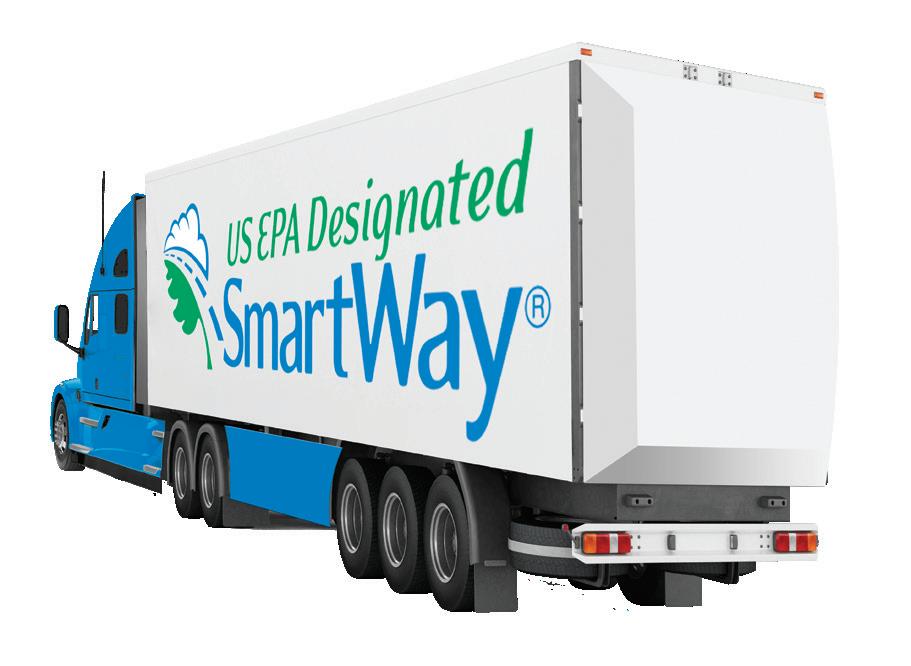




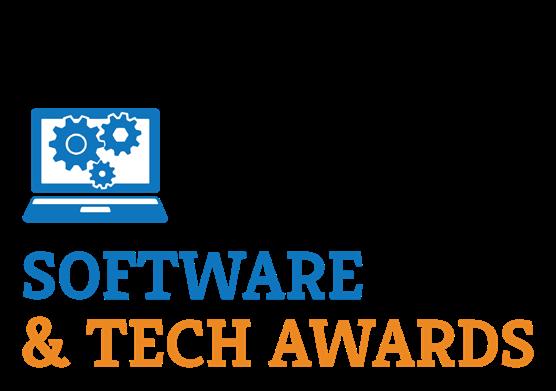
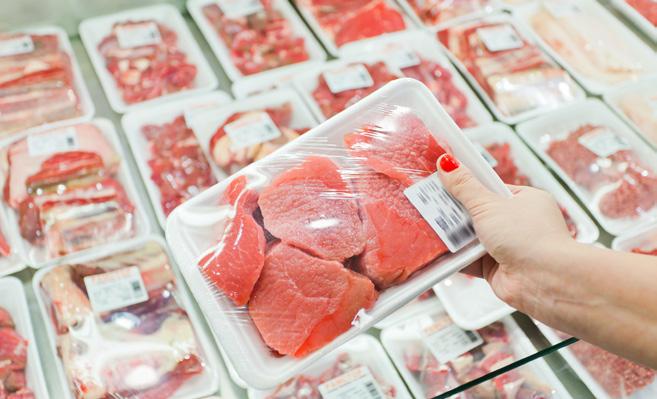


This time last year, I reported that supply chains were in a grim state. Telling folks, it’s only going to get worse before it gets better. Explaining how the supply chain was an absolute mess.
All of it was true.
And to some degree, still is the case today.
From port strikes to rail strikes, to food inflation, driver shortage and other disruptions that continue to hammer many of today’s supply chains, it’s been a year.
But, the tides seem to be turning in favor of a more normalish year for global supply chains.
Nearly 45% of economists surveyed by the Wall Street Journal estimated bottlenecks would ease by the second half of 2022.
Citi economists said logistics pressures from excessive consumer demand for goods are easing up.
And, according to SeaIntelligence, models suggest that a return to “normal” at a 2% capacity loss baseline by early 2023 is possible. But, what does normal really mean anyways? This “New Normal” isn’t really new, it’s just different, it’s a reality that continues to keep companies on their toes and consumers in check.
It’s normalish. That’s because disruptions
have always been a part of supply chains. Bottlenecks of many kinds like natural disasters, roadblocks and other unforeseen circumstances aren’t new. They didn’t just crop up when the pandemic hit.
It’s called life.
I think the challenge now is that these disruptions are happening all at once, from different angles, impacting various parts of the supply chain, at the same time.
While this normalish way of operating has posed some really tricky challenges, it’s also presented paths to opportunity and improvement.
Kudos to the winners from this year’s Top Software & Tech Providers award, who develop emerging technologies making the difference for companies in need of flexibility, efficiency, safety, visibility and more. (Go to page 26 to view the list of this year’s winners).
And shout out to the industry execs who participated in this issue’s cover story to explain how implementing the right technology, hitting some sustainability marks and overcoming disruptions will set the stage for this New Normal, which going forward, will be the only way to operate. (Go to page 14 to read the cover story).
It’s normal for supply chains to be disrupted. It’s normal for industry leaders to work to stay resilient. Time to make the New Normal more normalish.
EDITORIAL
Editor-in-Chief Marina Mayer mmayer@ACBusinessMedia.com
Associate Editor Alexis Mizell amizell@ACBusinessMedia.com
Audience Development Manager Angela Franks
PRODUCTION
Senior Production Manger Cindy Rusch crusch@ACBusinessMedia.com
Art Director Willard Kill
Brand Director Jason DeSarle jdesarle@ACBusinessMedia.com
Sales Associate Brian Hines bhines@ACBusinessMedia.com
Account Executive John Specht jspecht@ACBusinessMedia.com
Account Executive Paul Petterson ppetterson@ACBusinessMedia.com
AC BUSINESS MEDIA
Chief Executive Officer Ron Spink
Chief Financial Officer JoAnn Breuchel

Chief Revenue Officer Amy Schwandt
Chief Digital Officer Kris Heineman
VP, Audience Development Ronda Hughes VP, Operations & IT Nick Raether
Content Director ..................................................... Marina Mayer
GM, Online & Marketing Services ..............Bethany Chambers
Content Director, Marketing Services Jess Lombardo
Director, Demand Generation & Education Jim Bagan
Director, Enterprise Sales Kay Ross-Baker
CIRCULATION & SUBSCRIPTIONS
P.O. Box 3605, Northbrook, IL 60065-3605 (877) 201-3915 | Fax: (847)-291-4816
circ.FoodLogistics@omeda.com
LIST RENTAL
Sr. Account Manager Bart Piccirillo | Data Axle (518) 339 4511 | bart.piccirillo@infogroup.com
Brian Hines
(647) 296-5014 | bhines@ACBusinessMedia.com
Published and copyrighted 2022 by AC Business Media. All rights reserved. No part of this publication may be reproduced or transmitted in any form or by any means, electronic or mechanical, including photocopy, recording or any information storage or retrieval system, without written permission from the publisher.
Food Logistics (USPS 015-667; ISSN 1094-7450 print; ISSN 19307527 online) is published 6 times per year in January/February, March/ April, May/June, July/August, September/October, and November/ December by AC Business Media, 201 N. Main Street, Fort Atkinson, WI 53538. Periodicals postage paid at Fort Atkinson, WI 53538 and additional mailing offices.
POSTMASTER: Send address changes to Food Logistics, P.O. Box 3605, Northbrook, IL 60065-3605. Subscriptions: U.S., one year, $45; two years, $85; Canada & Mexico, one year, $65; two years, $120; international, one year, $95; two years, $180. All subscriptions must be paid in U.S. funds, drawn from a U.S. bank. Printed in the USA.
Published by AC BUSINESS MEDIA 201 N. Main Street, Fort Atkinson, WI 53538 (800) 538-5544 • www.ACBusinessMedia.com
WWW.FOODLOGISTICS.COM



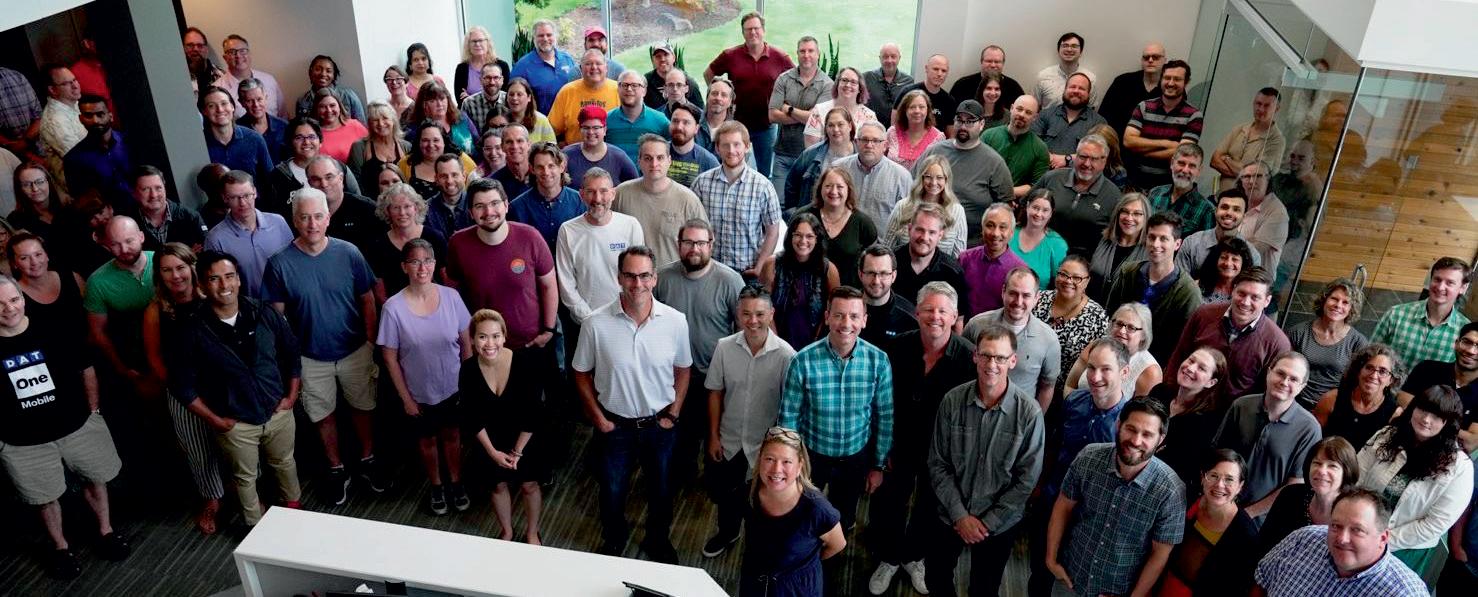
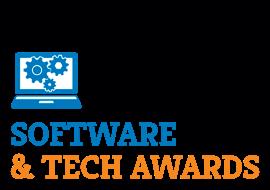
Freight & Analytics has long been known for its load board network. With more than 75,000 reefer trucks posted each week, and accessible through DAT’s own software and leading TMS products, DAT One is an essential source of capacity for food producers and distributors with unplanned or surplus freight.
But lately DAT has evolved into a SaaS leader and freight data analytics powerhouse. Established in 2019, the company’s DAT iQ business provides comprehensive truckload price analysis and rate forecasting tools to help food logistics professionals benchmark, ne gotiate and manage truckload capacity.
“We’re proud to be a Food Logistics Top Software Provider for 2022,” said Claude Pumilia, DAT President and CEO. “Food producers and distributors are a critical part of our user base and their unique needs have helped drive de velopment of the products we’re being recognized for today.”
DAT iQ’s analytics and SaaS products help users in three key areas:
DAT iQ users can see prevailing mar ket rates in seconds and compare their own spot and contract prices to industry averages from a trusted, neutral source. They can analyze historical patterns for a week, month, quarter or year; benchmark RFPs and routing guides; identify savings; and evaluate the cost-benefit of procur ing reefer trailers based on $137 billion in freight transactions, with rate forecasts that are over 95% accurate across more than 7 million daily predictions.
DAT iQ provides a 360-degree view of truckload capacity, with dynamic indi cators of changes in truckload supply and demand. By incorporating actual inbound and outbound freight transac tions and load-board post and search behavior, DAT iQ allows users to see where trucks are hardest to find; which
days deliver the best pricing power; plus capacity trends for the past, pres ent and future.
With robust business intelligence and benchmarking capabilities, DAT iQ em powers procurement teams to measure their performance by lane, carrier, region and more, benchmarking their results against the broader market.
With DAT’s SaaS products, logistics teams can effectively negotiate and manage capacity, create flexible routing guides, control costs, develop robust carrier portfolios and achieve the opera tional agility needed to stay ahead.
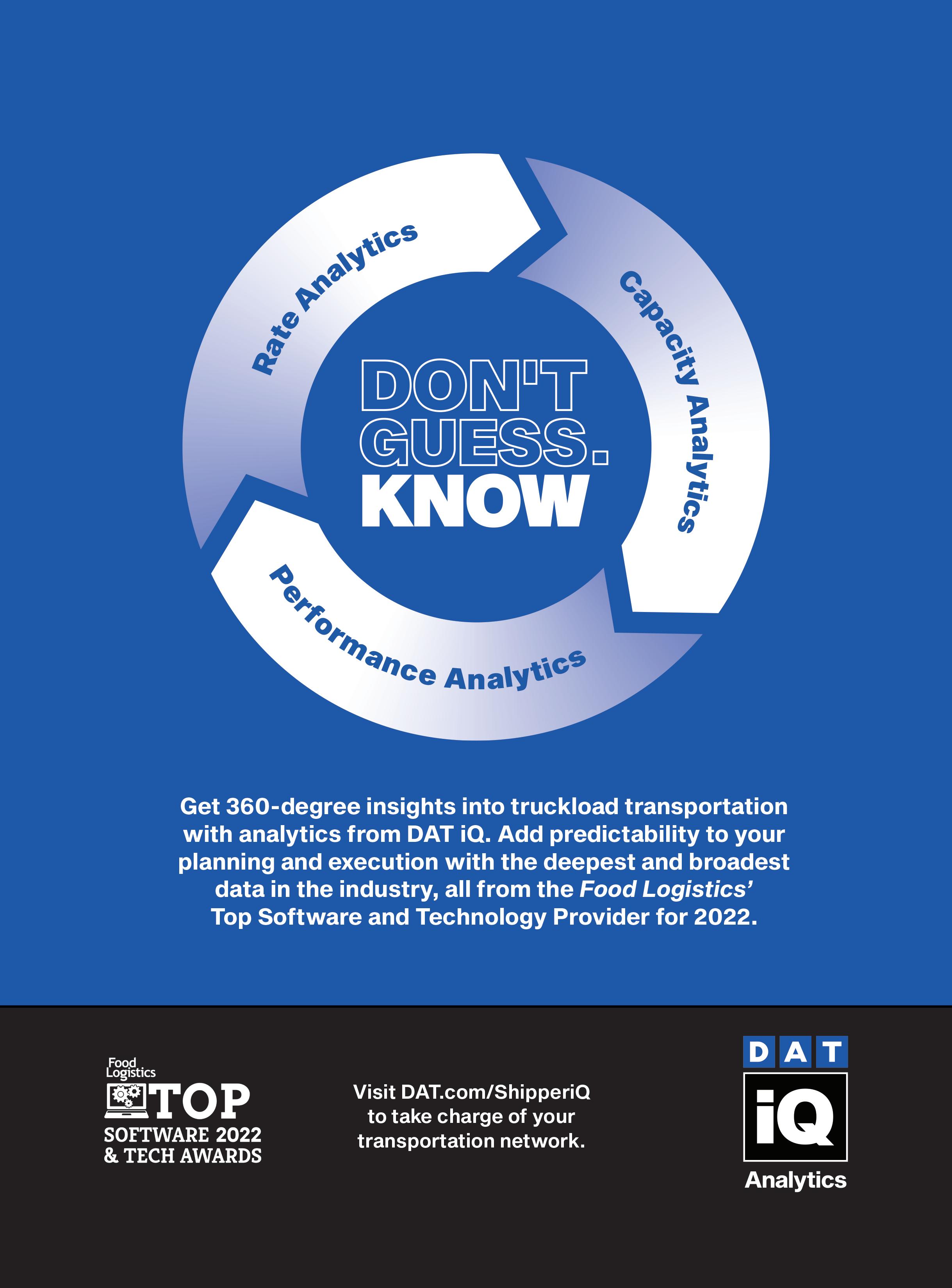
The food supply value chain is vast, stretching from the sewn seed through to stores and supermarkets. Big data is often utilized from the very first stage of food production, considered the growing stage, to aid in fertilization, irrigation and crop disease management processes. However, the uses and benefits of this data extend far beyond just these elements and far beyond the farmers’ field, according to Ron Baruchi, CEO of Agmatix.
By leveraging big data and AI, crop nutrient requirements can now be calculated accurately and effectively, and can even be tailored to each individual crop type and growing conditions. Data such as rainfall, temperature and soil type are added to fertilization and yield data for each specific crop variant to create a holistic view of the individual crops’ nutritional and management needs. This data is then analyzed using advanced AI and can be leveraged by food manufacturers to ensure growing practices are as efficient, cost-effective, productive and sustainable as possible.
By providing their growers with bespoke, live crop nutrition plans to achieve optimal yield, food manufacturers can guarantee they receive top quality ingredients and a maximal, predictable truck load from their suppliers. This, in turn, also unlocks key environmental benefits by reducing waste and minimizing disruptions to their production processes.


Scan the QR code to learn more https://foodl.me/6ak4u5


EROAD introduced CoreHub Xtreme, a next-generation Internet of Things (IoT) trailer monitoring and control gateway designed for supply chain assurance and optimized fleet efficiency for cold chain transportation. The CoreHub Xtreme delivers real-time data from all connected assets into a single platform to boost driver safety and fleet health.
Recent statistics from the United Nations report are alarming, showing world hunger rose in 2021 and around 2.3 billion people were moderately or severely food insecure. David Charles, SVP at Proxima, says the future could get even worse if we don’t take any action. Significant concerns, challenges and consequences may lie ahead as the current food supply crisis is expected to worsen. There needs to be a push by industries to build resiliency across global food supply chains whether it is by establishing better business practices or creating and investing in new agricultural innovations.
The world is facing a food crisis that is only getting worse but the significant challenges that lie ahead, there are many ways we can all work together to create solutions. It will take governments, policymakers, producers and even consumers to take immediate actions on urgent solutions, or the world could face dire consequences.
Scan the OR code to learn more https://foodl.me/vkhcai
“Our daily lives are affected by reefer and cold chain transportation whether we realize it or not. Protecting those goods and the drivers who are transporting them is crucial,” says Akinyemi Koyi, president of North America, EROAD. “Because of this, we are excited that the merging of EROAD and Coretex led us to be able to develop a richer solution to solve issues such as these. CoreHub Xtreme empowers fleet managers and their drivers with the ability to not only monitor the driver, asset and load in real-time, but also diagnose and prevent potential bad outcomes like lost loads—further contributing to both driver and cargo safety and cost savings.”
Scan the QR code to learn more https://foodl.me/xk1vd6
Almost three-quarters of the world’s current food production will face extreme risks from heat stress by 2045, according to new research from Verisk Maplecroft, impacting food production in major economies such as China, India, Brazil, and the United States.
“If emissions remain unchecked and temperatures continue to rise, extreme heat-related disruptions to global food supply chains will become increasingly common,” says Verisk Maplecroft’s head of climate and resilience Will Nichols. “This will further raise prices, strain economies and push millions toward hunger.”
Scan the QR code to learn more https://foodl.me/1j21z3

@sveta.stock.adobe.com
With storage, logistics and distribution facilities strained to the limit today, managers are now looking to cost effectively optimize operations without leasing more space or expanding the building with new construction when they have essentially run out of space.
Del Williams, technical writer at Steel King Industries, says versatile options are available in the industry that can help to make the most of facility vertical space and storage density. The cumulative effect of taking advantage of some, or all, of these offerings can substantially improve supply shock resilience in preparation for the next pandemic surge, natural disaster, war, political dispute or other black swan event.
Options in expansions include:
• Leveraging vertical cubic space
• Above the doors
• Increasing storage density
Scan the QR code to learn more https://foodl.me/qku5mc
@gorodenkoff.stock.adobe.com
Working in commercial kitchens, food manufacturing sites or grocery stores requires employees to use repetitive movements, stand in one place for long periods, use awkward postures and operate improperly designed workstations and equipment. Woody Dwyer, director of loss at AmTrust Insurance, says these duties can all lead to injuries known as musculoskeletal disorders (MSDs), which include injuries or disorders of the muscles, nerves, tendons, joints, cartilage and spinal discs.
The Bureau of Labor Statistics reports that these strain and sprain injuries represent approximately 35% of workplace injuries. On average, these types of strain injuries account for $12 million in paid losses, according to the report. Back and shoulder strain claims are very common in workers’ compensation, and these injuries can also lead to increased absenteeism and decreased productivity for employers.
Several large food manufacturers are currently investigating the use and implementation of exoskeletons in the workplace. They see the potential use of exoskeletons to help workers lift heavy materials and work with the employees’ arms at or above shoulder level.

Scan the QR code to learn more https://foodl.me/ccgkp4



The livelihood of your home delivery business depends on getting food there at the perfect temperature. You need to know—not just hope that your refrigeration equipment is up to the task. Frozen, fresh or anywhere in between, Thermo King has you covered with a complete line-up of temperature control solutions for small vans and trucks. Units feature quiet, multi-temperature operation, with electric standby options available. We continually test and innovate our products so your business can STAY ON THE MOVE
Learn More at: thermoking.com/homedelivery
Demand for last-mile grocery delivery skyrocketed during the pandemic as online grocery sales soared and many sheltered in place. According to Khaled Naim, co-founder and CEO of Onfleet, both delivery and online sales continue to grow despite inflation.
Food-at-home prices increased more than 13% over the past 12 months, marking the largest 12-month increase in 43 years. Though consumer price sensitivity is at an all-time high, Americans have become dependent on online ordering and delivery services for staple consumer goods because of the convenience and added health safety. So, as we hopefully near a post-pandemic era, what will the future hold for the last mile?
• Demand for faster, more streamlined last-mile grocery delivery will continue to grow as consumer expectations rise.
• Ease of scalability will be key to grocer success with last-mile delivery.
• Grocers will leverage delivery management technology to make delivery a competitive advantage.
• Modernization of the last mile will become a reality as more grocers begin their digital transformation.

As last-mile delivery becomes essential to consumers, the cost of inaction in the grocery delivery market will be steep. Scan the QR code to learn more https://foodl.me/3ciu1m

An ABB survey revealed a growing trend in U.S. and European businesses toward re-shoring or nearshoring operations to build resilience in the face of global chal lenges, however there is a significant education gap in the skills necessary for these strategies to succeed.
“The world is constantly evolving—businesses are shifting existing structures and adopting new technol ogies to future-proof their operations for a variety of challenges and uncertainties, with robotic automation playing a key role,” says Sami Atiya, president of ABB’s Robotics and Discrete Automation Business. “We need significant investment in continuous education to prepare our existing and future workforce to thrive in an age of robotics and automation, important not only to prepare for the widespread shifts we are seeing, but to create prosperous societies going forward.”
Scan the QR code to learn more https://foodl.me/b5bfkc
U.S. supply chains dodged a rail strike, one that would’ve embargoed shipments and further crippled global supply chains. These disruptions could have extended beyond the rail sector itself, and affected other transportation modes, primarily trucking, according to Uber Freight, who estimates that even if 20% of rail freight shifted to trucking, spot rates could’ve doubled in just that short period of time.
“As we’ve learned from the past two years, the truckload market is very sensi tive to disruptions in supply and demand. While spot rates react quickly to such changes, contract rates lag by a few months. Therefore, a disruption of this magnitude would have a direct impact on spot rates,” according to Uber Freight.
Data indicates that the average weight of a carload is 128,000 pounds and that of an intermodal load is 33,000 pounds.
According to the Commodity Flow Survey, rail carries about the same amount of freight as for-hire truckloads (measured in ton-miles).
When excluding local hauls (less than 100 miles) and light loads (less than 10,000 pounds, which are likely LTL shipments), rail carries 33% more freight than long-distance for-hire truckloads.

Total emissions produced by all the truckload freight and 20% of the served rail freight would have increased by 19%.
Scan the QR code to learn more https://foodl.me/dmluym
In addition to the known supply chain shortages, the current trucking industry challenges are having negative impacts on cold chain integrity, increasing the potential for temperature excursions that could accelerate the degradation of perishable food quality and safety. Yet, despite the emerging complexities of this new trucking industry landscape, cold chain stakeholders have access to data analytics, tools and services to help them maintain their strict quality standards, according to Doug Thurston, VP of sales, cold chain digital solutions at Emerson. Most importantly, data provides an objective record of cold chain temperatures in-transit. In challenging times like these, where truckers and retailers simply can’t afford the negative impacts of rejected loads, data serves as an arbiter of supply chain disputes. It takes emotion out of the equation by providing indisputable proof of precisely when and where temperature excursions occur.
Scan the QR code to learn more https://foodl.me/kpn0v7


With stiff global competition and un precedented supply chain problems, material handling teams are facing more pressure than ever before to keep both performance levels—and costs—in check.
However, in a field still marked by legacy technologies and workflows, material handling managers still face many challenges, including:

• Employee productivity and throughput
• Equipment maintenance, fuel and upgrade costs
• Labor shortages and high turnover rates
• Safety concerns and associated expenditures
Many material handling teams are rethinking their workflows and investing in more modern equipment, such as forklifts powered by lithiumion batteries, in order to mitigate their

operational and financial hurdles.
Yet this is only part of the equation— and solution to material handling challenges. When acquiring new technology, it is important to truly understand the difference between procurement from a supplier and procurement from a business partner. Manufacturers like UgoWork go the extra mile to help material handling teams leverage the performance of their lithium-ion batteries for forklifts and Energy as a Service (EaaS) solutions to achieve operational goals.
Customer Success Managers: Energy experts that crunch numbers and offer guidance UgoWork’s Energy as a Service (EaaS) and forklift batteries are backed by a robust Customer Success team made up of energy experts. Each customer is assigned a
UgoWork | Lithium-ion batteries for industrial trucks

dedicated Customer Success Manager (CSM), who becomes the single point of contact for whoever needs to work with UgoWork’s solutions, whether it’s the material handling manager, floor supervisors or forklift operators.
The CSM works closely with team members on several fronts, from the initial technological transition, training and post-sales support to digging deep into the customer’s analytics portal to make sense of the performance data. The CSM’s proactive monitoring of the customer’s forklift fleet and deep dive into the data allows them to gain insights to boost operational efficiency and lower costs. And these recommendations prove to be invaluable for the customer’s bottom line.
Interested in learning more about how data analytics and a customer success management approach can help you achieve your operational goals? Visit ugowork.com.






Natural disasters, port strikes, rail strikes, worker shortages, inflation and risk continue to present bottlenecks in all facets of the supply chain.
Industry experts offer hope to a return to normalcy in the supply chain space, but it will be a New Normal of sorts and quite the bumpy ride in getting there.
The New Normal… a phrase created shortly after the pandemic was in place to signify the new way of doing business.
But for many supply chains, that “new” way of doing business changes constantly, forcing decision-makers to continuously pivot.
Here’s how it usually goes: Supply chain disruption occurs. Develop new plan. Implement new process. Execute. New disruption occurs. Pivot again. Rinse and repeat.
At some point, when is the “New Normal” not so new? At what point does the New Normal become Old News? Begs the question of, what does a normal supply chain really even look like?
Is it disruption-proof? Is it cybersecurity-safe? Is it running on all cylinders with a full staff? Is it equipped with all the latest tools and technologies? Is it automated, cloud-based or hands-free?
Better yet, does this so-called “normal” supply chain even exist?
Prior to 2019, nearly all supply chains were considered normal. They operated the same way, day in and day out, with only a few hiccups here and there.
Post-pandemic though, normal has been redefined to better suit the nature of how supply chains operate in a disruption-laden environment.
Natural disasters, port strikes, rail strikes, worker shortages, inflation and risk continue to present bottlenecks in all facets of the supply chain, leading some to believe that the logistics space may never achieve normalcy again.
Case in point: Nearly 45% of economists surveyed by the Wall Street Journal estimated bottlenecks would ease by the second half of 2022. Yet, here we are, about to turn the page to 2023, and the supply chain still seems anything but normal.
China, for example, continues to enforce a zero-COVID-19 policy “that can partially or fully lock down major cities like Chengdu, Shenzhen, Xian, or Shanghai,” says Mirko Woitzik, global director, intelligence solutions at Everstream Analytics. “While this persists, we will continue to see port, airport and city shutdowns, as well as extended travel bans, which will impact supply chain logistics.”
“The global economic slowdown and rising inflation rates will also create workforce and labor issues within the supply chain. This will add financial pressure to many parts of the supply chain that are still reeling from the impacts of COVID-19 coupled with the war in Ukraine. Cost-cutting measures will likely increase labor shortages in critical parts of the supply chain from food production to ports and railways, which have the potential to cause further turmoil,” adds Woitzik.

Other factors such as inflation and rising fuel costs, to name a few, continue to put a strain on the supply chain.
On the other hand though, several industry leaders detail how this return to normalcy may not be as far-fetched in 2023 as currently perceived, but it will still be very different from prepandemic.
Arctic Xtreme™ labels resist moisture and frost build-up for 100% accurate scans every time. They also feature a durable top coating for added protection from warehouse bumps and knocks.
No wonder the readers of a leading magazine just named it a product of the year.
ID Label engineers Arctic Xtreme labels to your unique requirements, including preprinted barcode sequences and custom colors and sizes. Our professional crews can even install them for you.
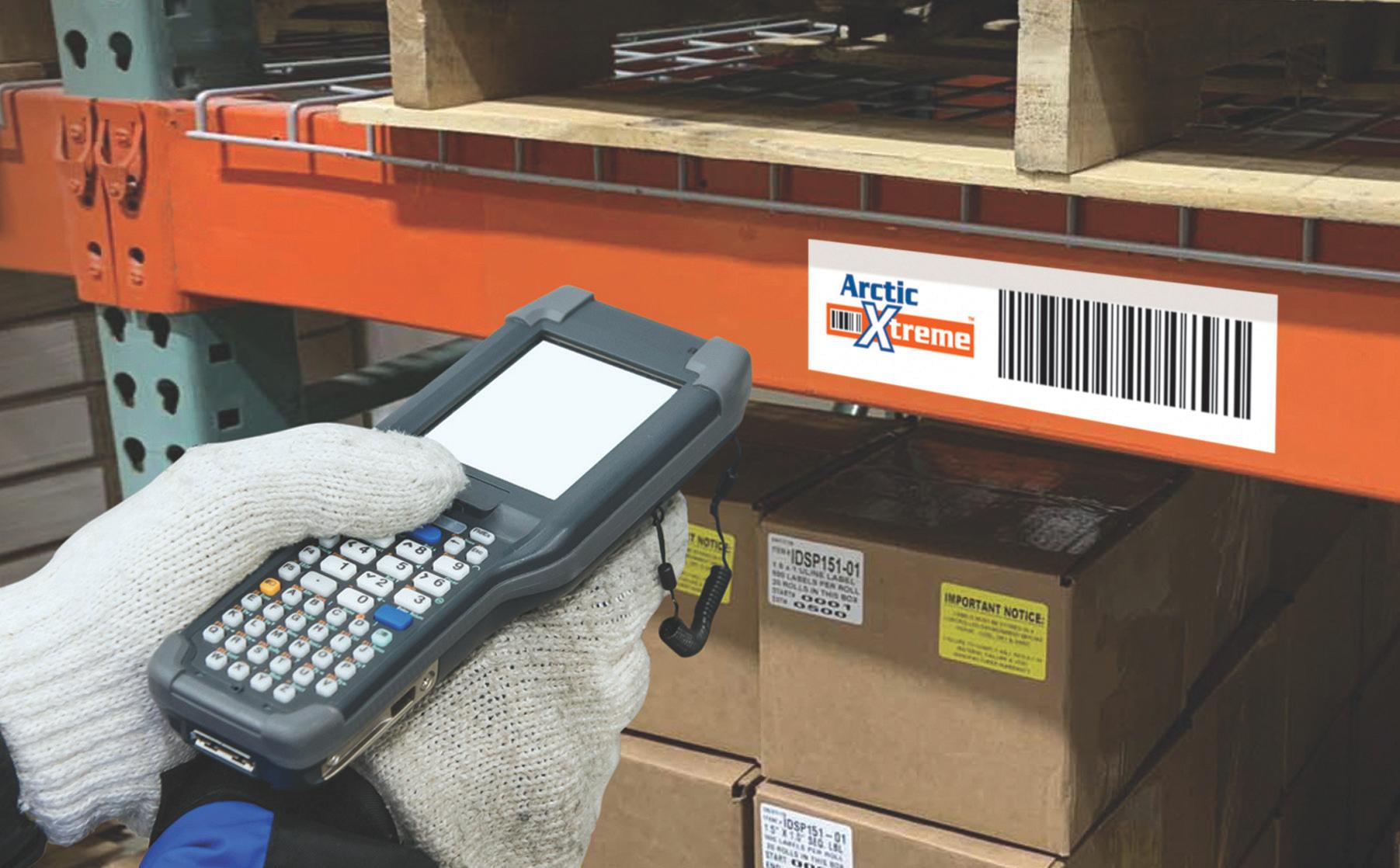
Xtreme Performance. Xtreme Value.
Our new Arctic Xtreme™ labels feature a freezer-grade, hybrid adhesive specially formulated for cold storage environments. They’re rated to perform at temperatures as low as -65F. And they can be applied at -20F to avoid any interruptions to operations.

When We Do the Barcodes, You Can Do More
Contact us today to request samples or a quote. 800-541-8506 • info@idlabelinc.com idlabelinc.com/AX
Supply chains are unlikely to stabilize until first half of 2024 and beyond, while 22% expect disruptions to continue until the second half of 2023, according to a Carl Marks Advisors survey.
In a separate report, Citi economists said logistics pressures from excessive consumer demand for goods are easing up, yet companies shouldn’t consider an “all clear” just yet.
The physical shortage of capacity, which drives up freight rates, doesn’t seem to be an issue at this time, according to SeaIntelligence, with models suggesting that a return to “normal” at a 2% capacity loss baseline by early 2023 is possible.

“In supply chain circles battered by more than two years of upheaval, the word ‘normal’ is creeping into the outlook for 2023. From the Logistics Managers’ Index to the New York Fed’s Global Supply Chain Pressure Index, we’re seeing forecasters more optimistic about the future outlook,” says Ben Harris, senior managing director, client solutioning and strategy at Cushman & Wakefield. “And while we’re optimistic that they’re right, we continue to see continuing challenges around raw materials and labor shortages, which are unchanged since last year at this time. Hopefully things will start to substantially ease by summer 2023, but it is going to be bumpy and uneven.”
In order to obtain somewhat of a normal way of doing business, companies must adhere to a New Normal, but in a way that’s defined as new on a regular basis. Think of it as an alternate state of the supply chain, where the timeline has skewed to create a new supply chain space [Back to the Future fans, anyone?]. This new continuum is laden with bottlenecks, strikes and challenges never before experienced.
And, it’s all happening at once. And, it’s all normal.
“Instability and disruption are the New Normal. We must acknowledge the inevitable and shift our focus not only to building more adaptive, responsive and resilient supply chains, but addressing the systemic factors that contribute to ongoing risks and rising costs,” says Tom Madrecki, VP of supply chain and logistics, Consumer Brands Association.
In early October, U.S. supply chains dodged a rail strike, one that would’ve embargoed shipments and further crippled global supply chains. President Biden enforced a 60-day cooling off period, where the Presidential Emergency Board looked at the disputed issues in the negotiations and issued a recommended settlement. These disruptions could have extended beyond the rail sector itself, and affected other transportation modes, primarily trucking, according to Uber Freight, who estimated that even if 20% of rail freight shifted to trucking, spot rates could’ve doubled in just that short period of time.
Fast forward a month later, and rail workers continue to express concern over their current labor contracts.
Analysts say a possible next shutdown could “hamper passenger service and slow the flow of goods to stores and warehouses. A union strike could cost the U.S. economy up to $2 billion per day, according to an estimate from the Association of American Railroads. Roughly 40% of the nation’s long-distance trade is moved by rail—more than any form
of transportation—and a union strike could stop more than 7,000 trains from operating,” according to Time.com.
Instabilities in this sector are projected to continue for the next couple of years.
Then there’s problems at the port, which didn’t just happen overnight and certainly didn’t start when the EVER GIVEN got stuck in the Suez Canal.
The backlog of inventory compounded with the oversupply of containers is contributing to second-hand container market prices plummeting, according to analysis from Container xChange.
“The current situation of oversupply of containers is a result of a series of reactionary market disruptions that began soon after the outbreak of the pandemic in early 2020. With the rise in demand, congestion at ports increased and the container capacity was held up for a considerably long period of time. This led to the panic ordering of new boxes at record levels. With time, as markets reopen and demand softens, the oversupply is a natural outcome of demand-supply forces
inflation and lockdowns, disruptions will continue to change the equation between supply, demand and prices.
balancing at new levels,” says Christian Roeloffs, co-founder and CEO of Container xChange.

Currently the industry is faced with several disruptions.
For starters, the Russia-Ukraine war doesn’t seem to be ending any time soon.
“Russia cutting off gas supplies to many parts of Europe is greatly affecting the price of energy in Europe. Currently, Europe is facing 10% inflation as of September 2022. We will likely see inflation soar even further during the winter months. The increase in costs has resulted in companies in Europe either shifting their production to other parts of the world or reducing their output. In some cases, companies that cannot afford it had to close, or stop production entirely. These problems will not be an overnight fix and will surely continue to be an issue into the new year,” says Woitzik.
Heightened financial volatility, sustainable development divestment, complex global supply chain reconfigurations and mounting trade
costs stemming from the war in Ukraine continue to impact trade and development, according to a new study released by the United Nations Conference on Trade and Development (UNCTAD).
“Soaring food and fuel prices will affect the most vulnerable in developing countries, putting pressure on the poorest households, which spend the highest
share of their income on food, resulting in hardship and hunger,” says UNCTAD Secretary-General Rebeca Grynspan.
In fact, “the biggest trend to watch has to be the slowdown in the growth of global trade. Between 2005-2019, there was an 84% increase in global trade. Obviously, the pandemic had an immediate and (so far) lasting impact on that growth. Now we’re hearing from the World Trade
The Port of Long Beach believes that moving to 24/7 operations is essential for the future of the supply chain. Visionary leadership helps make us the Port of Choice.

Hurricane Ian affected nearly 5 million acres of agricultural land.
Organization that they’re projecting further slowdowns in 2023 due to economic headwinds,” according to Harris.
What’s more is, customer expectation remains a huge challenge for the supply chain.

“If parents have a sick child, they can order soup from a restaurant or cough drops from the local convenience store and have them delivered directly to their door through apps like UberEats and DoorDash. They can even track where their items are throughout the process until it arrives. This type of expectation of visibility and expediency is going to increase across the supply chain,” says Jennifer Karpus-Romain, executive director for Transportation Marketing & Sales Association (TMSA).
The availability of ingredients and shortages in some food products continue to challenge the food sector, specifically the frozen food category.

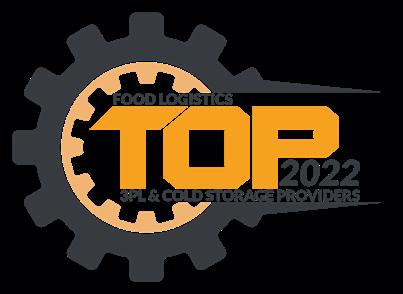

“Manufacturers may still need to reformulate or make labeling changes in response to ingredient shortages. The frozen food industry in particular is facing the diversion of soy and canola oil to make biofuels for government transportation subsidies and manufacturers face crisis-level shortages in edible vegetable oil for producing many frozen foods,” says Alison Bodor, president and CEO at American Frozen Food Institute (AFFI).
Furthermore, other disruptions such as inflation and labor shortages continue to put a damper on the industry.
“The trucking industry is already plagued with driver shortages. Warehouses faced similar issues earlier this year and last year. Staffing complexities and labor shortages will be an ongoing trend next year as well,” says Adhish Luitel, senior analyst, ABI Research. “Inflation has grown rapidly this year globally and a lot of regions in the world are now dealing with the highest level of inflation in years. Businesses must be prepared for cost increases related to procurement, finished products, wages, transportation

fees, storage space rent and more. Coping with inflation and trying to minimize its impact would entail fixing a lot of inefficiencies across supply chains.”



And, it’s those inefficiencies that could pose disruptions all on their own.
“As we approach the end of 2022 and enter 2023, I anticipate a state of continued supply chain instability and disruptions for the next year, if not longer. Consequently, issues of accuracy in demand forecasting will continue to be a major pain point for retailers,” says Troy Prothero, SVP, product management, supply chain solutions, SymphonyAI Retail CPG. “From changes in purchasing and consumption patterns that resulted from the past two years to inflation and geopolitical events, all of these factors combined create a perfect storm for supply chain disruption. What’s more, retailers can no longer rely solely on historical demand data as a basis for forecasting.”
“As a result, retailers must look to their demand forecasting technologies and ensure predictions are as agile, data-driven, science-based and accurate as possible,” Prothero says. “In addition, it’s crucial to proactively look at scenarios that might occur and plan how to act ahead of time, rather than just react to them.”
Industry experts offer hope to a return to normalcy in the supply chain space, but
disruptions, the New Normal will be the only way to operate going forward.
It’s no secret that warehouse labor positions are the hardest to fill and the most likely to experience high turnover. In the current job market, the winners are those who see the opportunity to invest in systems that require low human interac tion. And even when human operators are required, the ergonomics of the system will determine the turnover rate.


Montana-based Doyles Sheehan, a leading distributor to convenience stores, capitalized on the opportunity to reinvent the order fulfillment process. They teamed up with Velociti Alliance North America, a technology leader for optimized order fulfillment solutions, to convert their warehouses from single-order picking to hybrid order/batch picking. While some areas of the warehouse are picked one order at a time, most areas benefit from batch-oriented picking and sorting, where one pass through inventory fills an entire truckload of orders.
Through analysis and simulation of the Doyles Sheehan order history using 3-D models, Velociti was able to take
their pick rate from 400 to 750 pieces per hour per employee. “Not only did the Velociti partnership significantly decrease our labor requirement, but we also increased throughput and accuracy with minimal training. The bottom-line addition to profit is significant,” says Pat Coulter, Director of Operations and Information Systems.


Using wearable technology, handsfree order selection, and cloud-based order optimization, Coulter has been able to achieve top-tier results without spending millions of dollars in automation. With Velociti, Doyles Sheehan has created more ergonomic jobs for a smaller staff of dedicated employees – people they can keep, because the work is manageable. With the labor savings, Coulter has been able to create incentives for highperforming associates, recognizing them for their dedication and ensuring that they stay engaged with the company for years to come.
For more information, head over to https://velocitialliance.com.

If you had to choose a theme for 2022, its likely you would point toward supply chain disruption. For third-party logistics (3PL) providers who saw soaring rates and strong demand over the past two years, the market remains favorable long-term, but 2023 will look very different with a double-digit decline in revenues as the market normalizes, says Evan Armstrong, president of Armstrong & Associates.
And while all signs point to a more stable market following the last few years of uncertainty, 3PLs are still likely to feel the impacts of that “new normal.”
Industry growth and increased service levels are the two biggest trends to look for in 2023, according to Chris Wilson, VP of business development at TA Services.
“Because 2021-22 was kind of a recovery period of getting out of the supply chain and COVID nightmares, now we are seeing more companies move from being reactive to be more proactive,” says Wilson. “We are seeing a lot of companies working a lot more with third parties, doing an integration of their
While all signs point to a more stable market following the last few years of uncertainty, 3PLs are still likely to feel the impacts of a New Normal.
supply chain with a third-party company as far as its transportation, its warehousing, its final mile, everything. Companies are relying on 3PLs a lot more than they used to.”
Shippers are also looking for proactive ideas from 3PLs to improve operations and reduce costs, says Armstrong, and that “3PL customers have evolved from wanting basic transportation and warehouse management skills to more strategic relationships. They are also looking at 3PLs for business continuity management and are seeking well-positioned 3PLs which can even operate in cases of disasters. Some customers are asking 3PLs to present their internal plans for labor shortages, disaster preparedness, work stoppage, weather-related transportation disruptions, technology outages and other risks to operations.”
Wilson notes that it’s no longer just about price, but what you can bring to the table. “It’s about positioning yourself to have the most options and the best options,” he explains.
Drew Herpich, chief commercial officer at Nolan Transportation Group and Transportation Insight, attributes the continued growth in the 3PL market to a level playing field.

“People are now starting to accept brokers on the same level as assets. Brokers for so long got a bad name out in the industry, and shippers have realized, especially after COVID, that brokers have similar capabilities as these assets do,” Herpich adds.
Shippers are also looking for 3PLs that have the flexibility to bend and sway as the market changes.
“You can no
Cold chain and dry warehousing capacity is tight and will continue to be a challenge throughout 2023.
longer take the approach of, ‘this is who we are, and this is how we do it.’ You have to be able to pivot and adjust to each individual customer,” Wilson explains.
He adds that shippers are looking for an “elastic logistics plan,” with a partner “that can look at the overall picture and offer options.”
This type of flexibility requires IT integration with transparency and visibility into both yours and your customers’ systems, “so that they’re able to know in real-time everything that is going on with their supply chain and that the 3PL is handling it,” says Wilson.
Cold chain and dry warehousing capacity is tight and will continue to be a challenge throughout 2023 as shippers look to 3PLs to find space and manage operations.
“Finding and managing warehouse and
transportation labor is another challenge and risk that is being passed on to 3PLs,” explains Armstrong.
Wilson says that 3PLs are being asked to take more product in and have more stock available, so if and when there are supply chain disruptions, the stock is readily available. However, this has created a major crunch on warehousing space.
In response, Herpich predicts the industry will see an increase in mergers and acquisitions this year among the biggest players.
“Being able to build or get the equipment or space to be able to build these refrigerated solutions is going to be tougher. To get the on-demand warehousing, you’re going to see a lot more M&A deals going down,” he says.


Wilson says a labor shortage across the supply chain is likely to be an even bigger problem for 3PLs this year.
According to an annual study by NTT

Getting perishables to the market in excellent condition is a tough job. But with our help, it’s a little easier. With a fleet of more than1,40053-foot refrigerated trailers and containers,Alliance Shippers Inc. has the capacity to manage the largest protective-service tasks.
When you have temperature-sensitive products and a time-sensitive schedule turn tous
www.alliance.com
Wilson predicts the solution for this shortage, in part, will be the integration of robotics in the warehouse. This also tracks with the findings in the study, which found 84% of 3PLs and 70% of shippers are either actively implementing or researching and reviewing augmenting their supply chain operations with new technology and/or automation to offset talent shortage.








As disruptions in the supply chain continue to resolve, Wilson predicts rates trending downward. While general freight volume is currently muted and rates for most modes are down significantly from the first half of 2022, Armstrong says more historically normal transportation rates and demand levels should progress into 2023.
This means that price will no longer be the biggest differentiator in a competitive 3PL landscape.
“When you’re looking to work with a new customer, everyone’s rates are going down into the ground right now. Its more about providing a service level and finding other services that provide a value-add for the customer,” Wilson says.
To that point, Armstrong says that value-added warehousing and distribution will continue to do well given the general lack of warehousing space, which is nearing a critical level in the cold chain and strong growth in e-commerce fulfillment and last-mile delivery.






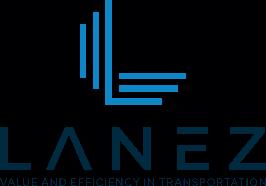
Digital freight matching will continue to pick up speed in 2023, with an increased focus on the automation of freight brokerage. This process automates traditional spot-market freight brokerage sales functions, and according to Armstrong, is increasing shippers’ use of more spot vs. contract pricing.
“The ongoing digitalization of transactional truckload freight brokerage continues at a rapid pace as more 3PLs have built API integrations to large shippers’ transportation management systems for truckload spot-market rate quoting and automated load tendering and booking,” says Armstrong, adding that it has become a competitive differentiator as 3PLs look to increase the number of loads and shipments they manage per person per day and revenue per person per year.
Sustainability will also be top of mind for many 3PLs this year.
“The solutions that we see today have not been exactly environmentally friendly or sustainable long term. You’re going to see much more sustainable solutions come to the forefront,” Herpich says.
Wilson points to green initiatives in the warehouse, specifically mentioning major grocery chains who in recent years have announced plans to reduce emissions, cut their carbon footprints and create greater efficiencies in the warehouse.
Lighting and temperature control are the two biggest areas companies are focusing on in the warehouse, with energy efficiency found through LED lights, skylights, sensors that monitor usage and turn off lights when not in use and highefficiency HVAC systems.
As warehouse capacity continues to tighten, Herpich says 3PLs will need to get more creative in keeping products cold.
“You are going to see people get more and more creative if they don’t actually have a cold storage warehouse,” Herpich says, adding that you’re also going to see more “from a packaging standpoint in being able to keep things cool because at the end of the day, the insurance and the claims can be costly if you don’t do it the right way.”
While interest in grocery delivery was already growing pre-pandemic, it is now the preferred method of grocery shopping for many consumers.
“There was a small niche of people who did home delivery of grocery, but that market has blossomed,” says Wilson. “Every major chain is now partnering with some sort of home delivery service. In the beginning, they would send a shopper to the store to fulfill the delivery, and now it’s working out of warehouses. Now, they’ve pivoted that there are warehouses just for that at-home delivery.”
3PLs place a lack of importance on reverse logistics, but considering the growing size of the market, it is suggested 3PLs may be missing out on “the untapped potential of reverse logistics to their overall growth and customer loyalty.

 AMY WUNDERLIN freelance writer
AMY WUNDERLIN freelance writer
In February 2020, MIT Management Sloan School predicted that machine learning, artificial intelligence (AI) and advanced analytics would be the top supply chain technologies set to deliver the most competitive advantage. And, then COVID-19 hit, catapulting these technologies into the forefront of supply chain operations worldwide.
Fast forward to three years later, and it’s these emerging technologies still making the difference for companies in need of flexibility, efficiency, safety, visibility and more.
This year’s winners of Food Logistics’ Top Software & Technology Providers award are investing in robotics, mobile technology, Internet of Things (IoT), food safety management, barcode systems, routing and scheduling, yard management and more; anything that offers end-to-end management, from farm to fork, and beyond to address challenges in the cold food supply chain, whether that be port closures, driver safety or just simply automating a process.
Here’s a breakdown of top software and technologies from this year’s winners:
• 66% of this year’s winners provide supply chain visibility solutions
• 57% provide supply chain management
• 41% provide predictive/prescriptive analytics


Website: austin-labs.com
Solutions Offered: Data synchronization, Demand management, Enterprise resource planning (ERP), Inventory control, Load planning, Predictive/prescriptive analytics, Routing and scheduling, Supply chain management, Supply chain visibility, Transportation management system (TMS) About: Austin Data Labs is a global data science and AI B2B SaaS company operating deep in the heart of the global food supply chain to help clients increase profits, reduce excess inventory, waste and reliance on spreadsheets, reduce carbon emissions, meet sustainability goals, better utilize data and resources and provide forecasting and decision making across all aspects of the supply chain.
“We’re built by experts in the food industries we serve, offering easy integration into existing systems like your ERP; no need to reinvent the wheel or abandon existing software that may have required years to implement,” says Austin Data Labs.
• 38% in mobile technology
• And 36% in systems integration
Congratulations to the winners of this year’s Top Software & Technology Providers award. Thank you for developing solutions that keep supply chains moving safely and efficiently, regardless of the disruption.
Below are some standouts in the industry:
CDL 1000 Website: cdl1000.com Solutions Offered: Load planning, Supply chain management, Supply chain visibility About: CDL 1000’s smart logistics technology is a technolo gy-driven drayage logistics leader that combines augmented intel ligence with AI to provide a more accessible solution for volume export customers to turn around their containers quicker—from loaded to unloaded and back to fully loaded. CDL 1000 promised a 24-hour turnaround to pull any container and remove it out of a U.S. port or rail yard, reducing customers’ late fees and storage costs by 20-50%. CDL 1000 also introduced Drayage-as-a-Service (DaaS) to digitize the drayage space. And, CDL 1000 digital Batch platform is a logistics solution that allows customers to list or bid on batches of shipments seamlessly, alleviating capacity issues, reducing waste, enhancing efficiency and increasing visibility. The platform also enables shippers to move 50-1,000 containers at a time.
“CDL 1000 has been working to save its customers up to half their overall transportation costs by reducing port demurrage and rail yard storage fees. The company promises a 24-hour turn around to pull any container and clear it out of a U.S. port or rail yard for customers. If it fails to meet that promise, CDL 1000 will pay demurrage and storage fees on behalf of customers. By mov ing containers quicker, CDL 1000 is helping customers save tens of millions of dollars each week that stem from demurrage fees associated with letting containers sit idle,” according to CDL 1000. “Seen as the FEMA of drayage, shippers can contact CDL 1000 when they’re in a bind to transport containers and keep shipments moving along the supply chain quickly and efficiently.”
“Generix Group’s two WMS solutions are key elements of the Generix Supply Chain Hub platform. They contribute to the operational excellence of its customers and help them meet today’s challenges,” according to Generix.

Solutions Offered: Data synchronization, Food safety management, Global trade management, Internet of Things (IoT), Mobile technology, Predictive/prescriptive analytics, Regulatory compliance, RFID, Supply chain management, Supply chain visibility, Systems integration
About: CMX’s solution provides the tools and automation to gain control and transparency and mitigate risk over complex multitier supply chains, focusing on the design, sourcing and ongoing safe delivery of food products and resolving issues when product incidents, withdrawals and recalls occur. CMX’s solution helps customers quickly pivot to comply with changing regulations and manage supply chain requirements, communications, collaboration and compliance. Beyond the supply chain, its solution gives brands a way to digitize and execute quality, safety and operational checks at the farm; supplier, distributor or retail location level, including performing food safety and temperature monitoring; facilities and equipment evaluations; employee pre-shift and wellness checks; sanitation and cleanliness protocols; brand standards compliance checks; and more.
“CMX’s single-platform technology approach gives us a distinct and definitive advantage over our competition,” adds CMX. “The CMX1 platform was engineered to address and overcome both the most difficult and the most common challenges in business applications: agility, adaptability, scaling, performance, integration and security. It is the base foundation upon which all of our clientfacing applications are built and delivered.”
Website: dat.com
Solutions Offered: Demand management, Freight payment, Load planning, Mobile technology, Predictive/prescriptive analytics, Regulatory compliance, Routing and scheduling, Supply chain management, Supply chain visibility, Systems integration, Transportation management system (TMS)
About: Food and beverage customers rely on DAT to help benchmark, negotiate and manage the refrigerated truckload capacity needed to optimize warehouse capacity and dock space. DAT’s iQ freight-data analytics service maintains a comprehensive database of truckload transaction information, with contributions from more than 1,000 companies, including food distributors, retailers and providers of temperaturecontrolled logistics. Customers use this data to accurately forecast and negotiate pricing for reefer truckload services, monitor demand for trucks geographically down to a threedigit ZIP code and evaluate the cost-benefit of procuring reefer trailers for storage, pooling and other uses. Meanwhile, DAT One delivers access to the deepest pool of refrigerated truckload capacity, with an average of more than 75,000 reefer trucks available each week in 2022. Through a partnership with FourKites, truck drivers can allow the loads they book through DAT One to be tracked using the ELD or GPS in their vehicles.
“Our DAT One freight marketplace is the largest in the industry: it hosts nearly 500 million truckload shipments a year and 1.4 million trucks, more than 25% of which involve reefer loads. You’re more likely to find a truck on DAT One than anywhere else,” according to DAT.

Website: generixgroup.com/en
Solutions Offered: Warehouse management system (WMS)

About: Generix’s SOLOCHAIN provides a wide range of capabilities that support logistics and manufacturing processes specific to the food and beverage industry, including advanced warehouse management and manufacturing execution, recipe management, work-in-process tracking, container management, lean manufacturing, quality assurance with electronic checklists, track-and-trace and electronic recall capability.

Website: johansontrans.com
Solutions Offered: Data analytics and visualization, Data synchronization, Food safety management, Global trade management, Load planning, Mobile technology, Predictive/
prescriptive analytics, Routing and scheduling, Supply chain management, Supply chain visibility, Transportation management system (TMS)
About: Several produce wholesale and retail clients use Johanson Transportation Services’ TMS to trace temperaturecontrolled shipments of lettuce, melons, celery, stone fruit, tomatoes and grapes. These solutions offer 24/7 visibility into their customers’ freight, from loading to delivery to ensure product hits the shelves in a timely manner while still fresh.
“JTS’ proprietary arriviture feature-rich TMS double as a supply chain analytics platform. Microsoft PowerBI is the technology fueling arriviture. Users have all their KPIs at their fingertips, including carrier spend, heat maps, lane maps and cost/pound distribution,” according to JTS.
Website: lanez.com
Solutions Offered: Customer relationship management, Data synchronization, Demand management, E-commerce, Global trade management, Inventory control, Load planning, Mobile technology, Predictive/prescriptive analytics, Routing and scheduling, Supply chain management, Supply chain visibility, Systems integration, Transportation management system (TMS)
About: Lanez is on the cutting edge of new programs to give more visibility into the end-to-end cold chain networks. Lanez has developed and is currently developing systems to give shippers full visibility of all shipments, including internationally.

“Lanez is able to pivot and develop their product tailor-made to a shippers/carriers’ needs at that time. They also can monitor and make necessary adjustments in a matter of minutes due to their superior customer service,” adds Lanez.
manage the factory floor and produce finished goods—all with automated and accurate lot traceability. Each step is tracked and scanned, with a system that warns employees if they accidentally scan in the wrong ingredient (ex: organic vs. nonorganic, allergen vs. non-allergen) into the current production run.
“Ordinary warehouse management systems and all-inone ERPs don’t support traceability or the one-to-many manufacturing processes inherent in food and beverage manufacturing. Unique in the industry, ParityFactory’s warehouse and production management system seamlessly handles co-products and byproducts, in both one-to-many and many-to-many processes, delivering accurate inventory control with a customer’s current ERP. Unlike an ordinary WMS or ERP, ParityFactory’s WMS and MES software includes work orders and production management,” says ParityFactory.

Website: openskygroup.com
Solutions Offered: Automated material handling solutions, E-commerce, Freight payment, Inventory control, Robotics, Routing and scheduling, Supply chain management, Supply chain visibility, Systems integration, Transportation management system (TMS), Warehouse management system (WMS), Yard management
About: Open Sky Group implemented Blue Yonder’s TMS to enable traceability from shipment to delivery and labor management software to drive out excess waste and keep costs competitive. Both tools increase order velocity. In return, Open Sky Group offers advisory services to help current and future clients evaluate new technologies, audit the performance of existing technology and apply the technology correctly. Open Sky Group also released Enhanced Client Billing, designed to increase clients’ visibility, enabling real-time capture of billable activities performed within a WMS or other systems, assigning client-specific contractual billing rates and creating invoices; and 3PL Client Portal, which provides clients with unprecedented visibility into their WMS.

Website: parityfactory.com
Solutions Offered: Barcode systems, Demand management, Inventory control, Internet of Things (IoT), Mobile technology, Warehouse management system (WMS)
About: ParityFactory’s WMS and production software track every ingredient into the operation, with critical quality control checkpoints at each stage. Detailed traceability reports make audits easier and enable manufacturers to scale their businesses with leading retailers. Furthermore, ParityFactory enables operations to dynamically create custom labels for each retailer requirement, so changes can be made as needed. Its barcoding and scanning dramatically reduces the time and effort it takes to
“Open Sky Group is a global specialist for Blue Yonder warehouse management, labor management and transportation management solutions. One of our greatest differentiators is our rapid implementation methodology, allowing for quicker installation and faster return on investment with supply chain solutions. Open Sky Group challenges traditional approaches to software implementation, working with clients to refine and match processes to the software vs. software to the processes. By discouraging modifications, our clients experience smoother, less expensive and lower-risk upgrades, averaging up to 30% in savings on maintenance costs on upgrades alone,” according to Open Sky Group. “
Website: nulogy.com
Solutions Offered: Barcode systems, Customer relationship management, Data synchronization, Inventory control, Mobile technology, Predictive/prescriptive analytics, Regulatory compliance, Routing and scheduling, Supply chain management, Supply chain visibility, Systems integration
About: Nulogy digitally enables brands to manage their supplier ecosystems as true networks, rather than linear chains. As a multi-enterprise supply chain business network platform, Nulogy is purpose-built for brands to collaborate more effectively with their external networks, including contract packagers, contract manufacturers, value-added 3PLs and raw and packaging suppliers, using real-time shop floor data.
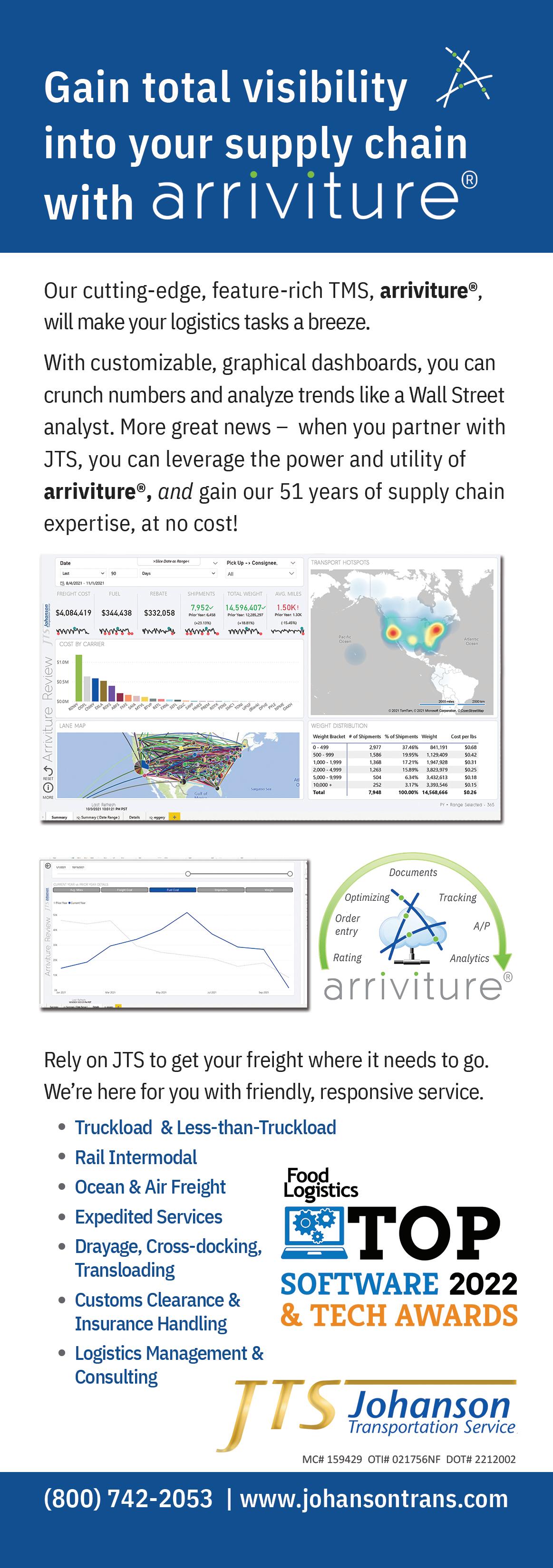

“Nulogy’s solutions address cost optimization, improved quality and traceability, enhanced service and speed, minimize leakage and spoilage of materials, inventory and labor and scale with growth,” says Nulogy. “No other solution is purpose-built to solve the challenges in visibility when it comes to collaborating with your contract supplier network.”
PLM Fleet, LLC Website: plmtrustlink.com Solutions Offered: Data synchronization, Food safety management, Inventory control, Internet of Things (IoT), Load planning, Predictive/ prescriptive analytics, Regulatory compliance, RFID, Supply chain management, Supply chain visibility, Wireless technology


About: The impact of using 50-year-old technology with ERP systems that don’t communicate has associated cost, especially as the proposed FSMA 204 Rule comes into play. PLM TrustLink provides the three Ts of supply chain—trust, transparency and traceability. PLM TrustLink captures critical tracking events and key data elements at the case level to provide financial and food safety benefits. Once a product is marked, it can then be digitized with a unique birth certificate to be shared within the facility and/or along the supply chain in a permissioned platform to provide benefits to reduce operational cost.
“PLM is not a technology company creating solutions; we are inside the cold chain creating technology solutions that are based on real ROIs in a 2% business pushing food down the supply chain,” says PLM Fleet. “PLM developed PLM TrustLink, which is a comprehensive, cloud-based IoT management solution for automated, touchless, supply chain ecosystems driving efficiencies at the product level.”
Website: tgiltd.com


Solutions Offered: Barcode systems, Customer relationship management, Data synchronization, Demand management, E-commerce, Enterprise resource planning (ERP), Food safety management, Inventory control, Internet of Things (IoT), Mobile technology, Regulatory compliance, RFID, Supply chain management, Systems integration, Warehouse management system (WMS), Wireless technology About: Technology Group International (TGI’s) E21 ERP system features forward and backward lot traceability, tracking all raw material lots received into inventory, raw material lot consumption through manufacturing processes, finished good lot production and eventual finished good lot shipment to customers. The advanced track-and-trace functionality allows food processors and distributors to execute mock and actual product recalls in seconds rather than hours or days. E21 ERP’s integrated EDI functionality provides for seamless electronic communication between the food processor or distributor and their customers, suppliers and outside warehouses. Through the built-in EDI platform, organizations can automate each step of their orderto-cash and procure-to-pay operations with data exchanged in real time and free from manual data entry processes.

“E21 ERP is developed, sold, implemented and subsequently supported directly by TGI. We do not outsource any aspect of our software development or technical support services. We believe this ‘single solution’ approach gives food processors and distributors a single partner relationship with their software provider for all business process consulting, process design, system integration and digital transformation needs,” according to TGI.










Open Sky Group helps cold food and beverage companies meet the ongoing challenges related to e-commerce, traceability, inventory management, and affordability. As global specialists in Blue Yonder warehouse, labor, and transportation management, food and beverage clients meet challenges via a rapid implementation methodology, allowing for quicker installation and faster return on investment. Our nomodifications approach allows clients to experience smoother, less expensive, and lower-risk upgrades, averaging up to 30% in savings. Additionally, Open Sky Group has released two solutions focused on increasing visibility for 3PL companies, Enhanced Client Billing (ECB) and 3PL Client Portal. ECB enables real-time capture of billable activities performed within a WMS or other event-based systems, assigns client-specific contractual billing rates, and creates invoices. 3PL Client Portal allows clients to provide their clients with unprecedented visibility into their WMS.

before forklift operators notice anything. Additionally, the state of health of all battery packs are monitored, so that UgoWork customers get lithium replacement packs when required. Doing so guarantees optimal performance and eliminates the risk of pack depletion. When a pack is replaced, UgoWork manages a responsible and sustainable recycling process, where up to 95% of
components are re-valued in the supply chain.
“Our cloud-connected battery management system enables performance tracking of the forklift fleet operation. UgoWork provides operation and fleet managers with energy consumption reports and trend analysis so that they can optimize fleet operations,” according to UgoWork.

Website: velocitialliance.com
Solutions Offered: Automated material handling solutions, Enterprise resource planning (ERP), Inventory control, Mobile technology, Predictive/prescriptive analytics, RFID, Robotics, Supply chain management, Supply chain visibility, Warehouse management system (WMS), Wireless technology
About: Velociti’s CloudLogic solution integrates with its CloudPick service on wearable devices to optimize product induction, putaway, picking, and packing operations. Its integration with warehouse robotics further reduces labor cost while accurately fulfilling orders in record time. Beyond the warehouse, Velociti integrates with leading providers to give visibility to the supply chain.
“By combining orders into optimized pick plans, Velociti’s CloudPick software condenses total travel time for a given to picker by more than 80%,” according to Velociti.
Agmatix | agmatix.com
Data synchronization, Mobile technology, Predictive/prescriptive analytics
Allen Lund Company, LLC | allenlund.com
Freight payment, Mobile technology, Routing and scheduling, Supply chain management, Systems integration, Transportation management system (TMS), Yard management
Automated material handling solutions, Barcode systems, Customer relationship management, Data synchronization, E-commerce, Enterprise resource planning (ERP), FinTech, Food safety management, Inventory control, Internet of Things (IoT), Load planning, Mobile technology, Predictive/prescriptive analytics, Regulatory compliance, Robotics, Routing and scheduling, Security solutions, Supply chain management, Supply chain visibility, Systems integration, Transportation management system (TMS), Warehouse management system (WMS), Wireless technology, Yard management
Apis Wise, LLC | apiswise.com
Barcode systems, Data synchronization, Food safety management, Inventory control, Manufacturing execution system, Regulatory compliance, RFID, Warehouse management system (WMS)
Automated material handling solutions, Food safety management, Load planning, Predictive/ prescriptive analytics, Regulatory compliance, Routing and scheduling, Security solutions, Supply chain management, Supply chain visibility, Systems integration, Transportation management system (TMS)
ArrowStream | arrowstream.com
Data synchronization, Inventory control, Predictive/prescriptive analytics, Routing and scheduling, Supply chain management, Supply chain visibility
Austin Data Labs | austin-labs.com
Data synchronization, Demand management, Enterprise resource planning (ERP), Inventory control, Load planning, Predictive/prescriptive analytics, Routing and scheduling, Supply chain management, Supply chain visibility, Transportation management system (TMS)
Authenticate | authenticateis.com
Food safety management, Supply chain management, Supply chain visibility
AutoScheduler.AI | autoscheduler.ai
Data synchronization, Demand management, Inventory control, Predictive/prescriptive analytics, Supply chain management, Supply chain visibility, Systems integration, Warehouse management system (WMS)
AutoStore | autostoresystem.com
Automated material handling solutions, E-commerce, Micro-fulfillment, Robotics, Supply chain management, Supply chain visibility, Warehouse management system (WMS)
BarTender by Seagull Scientific | seagullscientific.com
Barcode systems, Inventory control, Internet of Things (IoT), Mobile technology, RFID, Supply chain management, Systems integration
Becker Logistics | beckerlogistics.com
Food safety management, Load planning, Routing and scheduling, Security solutions, Supply chain management, Supply chain visibility, Systems integration, Transportation management system (TMS)
Blue Link Associates Limited | bluelinkerp.com
Enterprise resource planning (ERP)
Barcode systems, Demand management, E-commerce, Enterprise resource planning (ERP), Freight payment, Global trade management, Inventory control, Internet of Things (IoT), Load planning, Mobile technology, Predictive/prescriptive analytics, RFID, Robotics, Routing and scheduling, Supply chain management, Supply chain visibility, Systems integration, Transportation management system (TMS), Warehouse management system (WMS), Wireless technology, Yard management
Data synchronization, Demand management, FinTech, Freight payment, Global trade management, Inventory control, Load planning, Mobile technology, Predictive/prescriptive analytics, Regulatory compliance, Supply chain management, Supply chain visibility, Systems integration, Transportation management system (TMS), Warehouse management system (WMS)
Mobile technology
C3 Solutions | c3solutions.com
Dock Appointment Scheduling, Internet of Things (IoT), Mobile technology, Routing and scheduling, Supply chain visibility, Systems integration, Wireless technology, Yard management
CalAmp | calamp.com
Internet of Things (IoT), Regulatory compliance, Supply chain management, Supply chain visibility, Wireless technology
E-commerce, Enterprise resource planning (ERP), Inventory control, Mobile technology, Supply chain management, Supply chain visibility, Systems integration, Warehouse management system (WMS)
CAMS Software | prospero.com
Freight payment, Load planning, Mobile technology, Regulatory compliance, Routing and scheduling, Supply chain visibility, Systems integration, Transportation management system (TMS)
Inventory control, Load planning, Routing and scheduling, Supply chain management, Supply chain visibility, Transportation management system (TMS), Warehouse management system (WMS)
Load planning, Mobile technology, Routing and scheduling, Supply chain visibility, Systems integration, Transportation management system (TMS), Wireless technology, Yard management
CDL 1000 | cdl1000.com
Load planning, Supply chain management, Supply chain visibility
CensaNext | censanext.com
Automated material handling solutions, Demand management, E-commerce, FinTech, Food safety management, Inventory control, Internet of Things (IoT), Predictive/prescriptive analytics, Routing and scheduling, Supply chain management, Supply chain visibility, Transportation management system (TMS), Warehouse management system (WMS)
Automated material handling solutions, Food safety management, Inventory control, Load planning, Robotics, Systems integration, Warehouse management system (WMS)
CMX | cmx1.com
Auditing, Data synchronization, Food safety management, Global trade management, Incident management, Internet of Things (IoT), Mobile technology, Policy management, Product lifecycle management, Quality assurance, Predictive/prescriptive analytics, Recall management, Regulatory compliance, RFID, Supply chain management, Supply chain visibility, Systems integration
Food safety management, Internet of Things (IoT), RFID, Supply chain visibility, Wireless technology, Yard management
Data synchronization, Supply chain visibility
Cloud-based control platform, Data synchronization, Demand management, Industrial automation software, Industrial control software, Internet of Things (IoT), Mobile technology, Predictive/prescriptive analytics, Regulatory compliance, Security solutions, Supply chain visibility, Systems integration
Automated material handling solutions, Internet of Things (IoT), Warehouse management system (WMS), Wireless technology
Dassault Systèmes | 3ds.com
Inventory control, Internet of Things (IoT), Predictive/prescriptive analytics, Robotics, Routing and scheduling, Supply chain management, Supply chain visibility
Demand management, Freight payment, Load planning, Mobile technology, Predictive/ prescriptive analytics, Regulatory compliance, Routing and scheduling, Supply chain management, Supply chain visibility, Systems integration, Transportation management system (TMS)
Deacom, an ECI company | deacom.com
Barcode systems, Customer relationship management, Demand management, E-commerce, Enterprise resource planning (ERP), Inventory control, Mobile technology, Predictive/prescriptive analytics, Regulatory compliance, Routing and scheduling, Supply chain management, Supply chain visibility, Systems integration, Warehouse management system (WMS)
DispatchTrack | dispatchtrack.com
Data synchronization, Demand management, Inventory control, Load planning, Mobile technology, Routing and scheduling, Supply chain visibility, Systems integration
DTG | dtgpower.com
Mobile battery-powered workstations, Mobile technology, RFID
Edge Logistics | edgelogistics.com/capacity
Supply chain management, Supply chain visibility
ELITE Transit Solutions | elitetransit.com
Load planning, Mobile technology, Predictive/prescriptive analytics, Routing and scheduling, Supply chain visibility, Transportation management system (TMS)
Emerge | emergemarket.com
Data synchronization, Demand management, Load planning, Supply chain management, Supply chain visibility
Emerson Cargo Solutions | emerson.com/cargo
Internet of Things (IoT), Mobile technology, RFID, Security solutions, Supply chain management, Supply chain visibility, Wireless technology, Yard management
Enveyo | enveyo.com
Data synchronization, Predictive/prescriptive analytics, Supply chain management, Supply chain visibility, Systems integration, Transportation management system (TMS)
EROAD | eroad.com
Data synchronization, Food safety management, Internet of Things (IoT), Mobile technology, Predictive/prescriptive analytics, Regulatory compliance, RFID, Routing and scheduling, Security solutions, Supply chain visibility, Systems integration, Wireless technology
ETQ (part of Hexagon) | etq.com
Food safety management, Predictive/prescriptive analytics, Regulatory compliance, Routing and scheduling, Supply chain management, Supply chain visibility
Everstream Analytics | everstream.ai
Predictive/prescriptive analytics, Supply chain management, Supply chain visibility
Financial Transmission Network, Inc. (FTNI) | ftni.com
Data synchronization, FinTech, Freight payment, Mobile technology, Systems integration
Fleet Advantage | fleetadvantage.com
Supply chain management, Supply chain visibility, Systems integration, Vehicle Asset Management
Foods Connected | foodsconnected.com
Food safety management, Supply chain management, Supply chain visibility
FreightSmith LLC | freightsmith.net
FinTech, Freight payment, Mobile technology, Supply chain visibility, Yard management
Generix Group | generixgroup.com/en
Warehouse management system (WMS)
Globe Tracker | globetracker.com
Supply chain visibility
Harven Inc | harven.co.kr
Internet of Things (IoT), RFID
Hwy Haul | hwyhaul.com
Freight payment, Load planning, Mobile technology, Routing and scheduling, Supply chain management, Supply chain visibility, Transportation management system (TMS)
Icicle Technologies Inc. | icicletechnologies.com
Barcode systems, Demand management, Enterprise resource planning (ERP), Food safety management, Inventory control, Internet of Things (IoT), Predictive/prescriptive analytics, Regulatory compliance, Warehouse management system (WMS)
E-commerce, Security solutions, Supply chain management, Supply chain visibility, Systems integration
InTek Freight & Logistics, Inc. | intekfreight-logistics.com
Customer relationship management, Data synchronization, Freight payment, Load planning, Mobile technology, Routing and scheduling, Security solutions, Supply chain management, Supply chain visibility, Systems integration, Transportation management system (TMS)
Cold storage monitoring, Dock door management, Food safety management, Forced-air cooling monitoring, Internet of Things (IoT), Mobile technology, Predictive/prescriptive analytics, Supply chain management, Supply chain visibility, Systems integration, Vacuum cooling monitoring, Wireless technology, Yard management
IntelliTrans | intellitrans.com
Data synchronization, Demand management, Freight payment, Global trade management, Inventory control, Internet of Things (IoT), Load planning, Predictive/prescriptive analytics, Regulatory compliance, Routing and scheduling, Supply chain management, Supply chain visibility, Systems integration, Transportation management system (TMS), Yard management
IQAX Limited | iqax.com
Internet of Things (IoT), Routing and scheduling, Supply chain management, Supply chain visibility
iQuantum Inc. | iquantum.ai
Supply chain management, Supply chain visibility, Systems integration
Johanson Transportation Service | johansontrans.com
Data analytics and visualization, Data synchronization, Food safety management, Global trade management, Load planning, Mobile technology, Predictive/prescriptive analytics, Routing and scheduling, Supply chain management, Supply chain visibility, Transportation management system (TMS)
Demand management, Inventory control, Predictive/prescriptive analytics, Supply chain management, Supply chain visibility
KoiReader Technologies, Inc. | koireader.com
Inventory control, Internet of Things (IoT), Mobile technology, Predictive/prescriptive analytics, Regulatory compliance, RFID, Supply chain management, Supply chain visibility, Warehouse management system (WMS), Yard management
Körber Supply Chain | koerber-supplychain.com
Automated material handling solutions, Barcode systems, Data synchronization, Demand management, E-commerce, Inventory control, Mobile technology, Predictive/prescriptive analytics, RFID, Robotics, Routing and scheduling, Security solutions, Supply chain management, Supply chain visibility, Systems integration, Transportation management system (TMS), Warehouse management system (WMS), Wireless technology, Yard management
Laird Connectivity | lairdconnect.com
Food safety management, Internet of Things (IoT), Predictive/prescriptive analytics, Wireless technology
Lanez, Inc | lanez.com
Customer relationship management, Data synchronization, Demand management, E-commerce, Global trade management, Inventory control, Load planning, Mobile technology, Predictive/ prescriptive analytics, Routing and scheduling, Supply chain management, Supply chain visibility, Systems integration, Transportation management system (TMS)
Loftware | loftware.com
Barcode systems, Enterprise labeling, Food safety management, RFID, Supply chain visibility
Logility, Inc. | logility.com
Data synchronization, Demand management, Inventory control, Routing and scheduling, Supply chain management, Supply chain visibility, Transportation management system (TMS), Warehouse management system (WMS)
Lucas Systems | lucasware.com
Voice-directed warehouse optimization technology
Lytx | lytx.com/en-us
Predictive/prescriptive analytics, Supply chain visibility, Systems integration, Video telematics, Wireless technology
Made4net | made4net.com
Labor management, Last-mile delivery, Routing and scheduling, Warehouse management system (WMS), Yard management
Manhattan Associates | manh.com
Inventory control, Supply chain management, Supply chain visibility, Transportation management system (TMS), Warehouse management system (WMS)
MercuryGate International | mercurygate.com
Demand management, Freight payment, Global trade management, Inventory control, Internet of Things (IoT), Load planning, Mobile technology, Predictive/prescriptive analytics, Routing and scheduling, Supply chain management, Supply chain visibility, Transportation management system (TMS)
Morpheus.Network | morpheus.network
Automated material handling solutions, Data synchronization, Demand management, Food safety management, Global trade management, Internet of Things (IoT), Middleware solution, Regulatory compliance, Routing and scheduling, Supply chain visibility, Systems integration
Ndustrial | ndustrial.io
Internet of Things (IoT), Predictive/prescriptive analytics, Systems integration
NECS, Inc. | necs.com
Barcode systems, Data synchronization, Enterprise resource planning (ERP), Inventory control, Mobile technology, Routing and scheduling, Systems integration, Warehouse management system (WMS)
NORMEX | normex.ca
Food safety management
Nulogy | nulogy.com
Barcode systems, Customer relationship management, Data synchronization, Inventory control, Mobile technology, Predictive/prescriptive analytics, Regulatory compliance, Routing and scheduling, Supply chain management, Supply chain visibility, Systems integration
o9 Solutions | o9solutions.com
Demand management, Inventory control, Predictive/prescriptive analytics, Routing and scheduling, Supply chain management, Supply chain visibility
Sky Group | openskygroup.com
Automated material handling solutions, E-commerce, Freight payment, Inventory control, Robotics, Routing and scheduling, Supply chain management, Supply chain visibility, Systems integration, Transportation management system (TMS), Warehouse management system (WMS), Yard management
ORTEC | ortec.com
3D load building, E-commerce, Education, Load planning, Mobile technology, Predictive/ prescriptive analytics, Resource forecasting, Routing and scheduling, Supply chain management, Supply chain visibility, Systems integration, Transportation management system (TMS)
| parityfactory.com
Barcode systems, Demand management, Inventory control, Internet of Things (IoT), Mobile technology, Warehouse management system (WMS)
Parsable | parsable.com
Data synchronization, Food safety management, Mobile technology, Predictive/prescriptive analytics, Supply chain management, Supply chain visibility
PCS Software | pcssoft.com
Load planning, Routing and scheduling, Systems integration, Transportation management system (TMS)
PLM Fleet, LLC | plmtrustlink.com
Data synchronization, Food safety management, Inventory control, Internet of Things (IoT), Load planning, Predictive/prescriptive analytics, Regulatory compliance, RFID, Supply chain management, Supply chain visibility, Wireless technology
Prosponsive Logistics | prosponsive.com
Customer relationship management, Freight payment, Load planning, Regulatory compliance, Routing and scheduling, Supply chain management, Supply chain visibility, Systems integration, Transportation management system (TMS), Wireless technology, Yard management
We built our platform to support the people and companies who nurture, make, and move the food that feeds the planet.

Your food logistics operation depends on leveraging your data, knowing what’s happening first in a volatile world, and the flexibility to make smart, fast, and accurate decisions and adjustments to keep costs down and reliability high. Using data science increases your profits, maximizes your time, and saves your sanity.

Don’t be crushed by spreadsheets – crush volatility with our data science platform. We aren’t guessing what your challenges are – we’ve lived them. Austin Data Labs’ award-winning scAIcloud® platform was built by industry experts for industry experts. We put data science at the heart of the global food supply chain. Reach out today at https://austin-labs.com/scAIcloud/
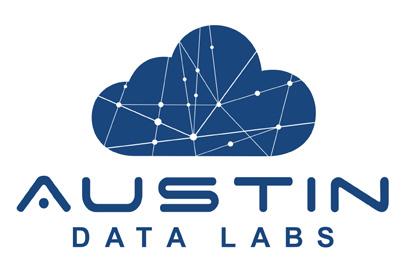
Raft (formerly known as Vector.ai) | raft.ai
Customer relationship management, Data synchronization, FinTech, Freight payment, Predictive/ prescriptive analytics, Supply chain visibility
Raymond Corporation, The | raymondcorp.com
Automated material handling solutions, Data synchronization, Internet of Things (IoT), Predictive/ prescriptive analytics, Regulatory compliance, RFID, Robotics, Warehouse management system (WMS), Wireless technology
Customer relationship management, Data synchronization, Load planning, Supply chain management, Supply chain visibility, Systems integration
| relaypayments.com
Data synchronization, FinTech, Freight payment, Mobile technology, Supply chain visibility
RoadSync | roadsync.com
FinTech, Freight payment, Mobile technology
Roambee | roambee.com
Internet of Things (IoT), Predictive/prescriptive analytics, Supply chain visibility, Wireless technology
Ryder System, Inc. | ryder.com
Automated material handling solutions, Barcode systems, Customer relationship management, Data synchronization, Demand management, E-commerce, Enterprise resource planning (ERP), Food safety management, Freight payment, Global trade management, Inventory control, Internet of Things (IoT), Load planning, Mobile technology, Predictive/prescriptive analytics, Regulatory compliance, RFID, Robotics, Routing and scheduling, Security solutions, Supply chain management, Supply chain visibility, Systems integration, Transportation management system (TMS), Warehouse management system (WMS), Wireless technology, Yard management
SemiCab Inc | semicab.com
Collaborative transportation platform. Digital freight solution
SFL Companies | sflcompanies.com
Freight payment, Load planning, Routing and scheduling, Supply chain management, Transportation management system (TMS)
Shipwell | shipwell.com
Enterprise resource planning (ERP), Freight payment, Load planning, Mobile technology, Predictive/prescriptive analytics, Routing and scheduling, Supply chain management, Supply chain visibility, Transportation management system (TMS), Wireless technology
Simfoni | simfoni.com
FinTech, Food safety management, Inventory control, Supply chain management, Supply chain visibility
Smart Gladiator | loadproof.com
Mobile technology, Security solutions, Supply chain management, Supply chain visibility, Warehouse management system (WMS)
SmartSense by Digi | smartsense.co
Food safety management, Internet of Things (IoT), Predictive/prescriptive analytics, Regulatory compliance, Supply chain visibility
Soft Robotics | softroboticsinc.com
Automated material handling solutions, E-commerce, Robotics
Specright | specright.com
Data synchronization, Food safety management, Mobile technology, Predictive/prescriptive analytics, Regulatory compliance, Supply chain management, Supply chain visibility, Systems integration
Spoiler Alert | spoileralert.com
Closeouts management system
Stoecklin Logistics, Inc. | stoecklin.com
Automated material handling solutions, Inventory control, Internet of Things (IoT), Predictive/ prescriptive analytics, RFID, Robotics, Systems integration, Warehouse management system (WMS)
SVT Robotics | svtrobotics.com
Automated material handling solutions, E-commerce, Industrial robotics deployment, Inventory control, Internet of Things (IoT), Robotics, Systems integration
SymphonyAI Retail CPG | symphonyretailai.com
Barcode systems, Data synchronization, Demand management, E-commerce, Food safety management, Inventory control, Load planning, Mobile technology, Predictive/prescriptive analytics, Routing and scheduling, Supply chain management, Supply chain visibility, Systems integration, Warehouse management system (WMS), Wireless technology
Automated material handling solutions, Barcode systems, Data synchronization, Demand management, Freight payment, Inventory control, Load planning, Predictive/prescriptive analytics, Routing and scheduling, Supply chain management, Supply chain visibility, Systems integration, Transportation management system (TMS), Warehouse management system (WMS), Wireless technology, Yard management
Barcode systems, Customer relationship management, Data synchronization, Demand management, E-commerce, Enterprise resource planning (ERP), FinTech, Food safety management, Inventory control, Mobile technology, Regulatory compliance, Robotics, Routing and scheduling, Supply chain management, Supply chain visibility, Systems integration, Warehouse management system (WMS), Wireless technology
Barcode systems, Customer relationship management, Data synchronization, Demand management, E-commerce, Enterprise resource planning (ERP), Food safety management, Inventory control, Internet of Things (IoT), Mobile technology, Regulatory compliance, RFID, Supply chain management, Systems integration, Warehouse management system (WMS), Wireless technology
TEKLYNX International | teklynx.com
Barcode systems, Data synchronization, Inventory control, RFID, Supply chain visibility, Systems integration
“Barcode systems, E-commerce, Enterprise resource planning (ERP), Food safety management, Global trade management, Inventory control, Internet of Things (IoT), Load planning, Mobile technology, Predictive/prescriptive analytics, Regulatory compliance, RFID, Routing and scheduling, Supply chain management, Supply chain visibility, Warehouse management systems (WMS), Wireless technology, Yard management
E-commerce, Freight payment, Load planning, Mobile technology, Predictive/prescriptive analytics, Routing and scheduling, Supply chain management, Supply chain visibility, Systems integration, Transportation management system (TMS)
Inventory control, Internet of Things (IoT), Supply chain management, Supply chain visibility
Transfix, Inc. | transfix.io
Load planning, Predictive/prescriptive analytics, Routing and scheduling, Supply chain management, Supply chain visibility, Systems integration, Transportation management system (TMS)
Customer relationship management, Data synchronization, Demand management, E-commerce, Enterprise resource planning (ERP), Freight payment, Inventory control, Load planning, Mobile technology, Predictive/prescriptive analytics, Regulatory compliance, Routing and scheduling, Security solutions, Supply chain management, Supply chain visibility, Systems integration, Transportation management system (TMS), Warehouse management system (WMS)
TransmetriQ, powered by Railinc | transmetriq.com
Equipment tracking, Predictive/prescriptive analytics, Shipment tracking, Supply chain management, Supply chain visibility, Track and trace, Transportation management system (TMS)
Trax | traxtech.com
Barcode systems, Customer relationship management, Data synchronization, FinTech, Freight payment, Supply chain management, Supply chain visibility
Trimble Transportation | transportation.trimble.com
Barcode systems, Internet of Things (IoT), Load planning, Mobile technology, Predictive/ prescriptive analytics, Regulatory compliance, Routing and scheduling, Supply chain management, Supply chain visibility, Transportation management system (TMS), Warehouse management system (WMS), Wireless technology
Load planning, Mobile technology, Predictive/prescriptive analytics, Routing and scheduling, Transportation management system (TMS)
Customer relationship management, E-commerce, Freight payment, Internet of Things (IoT), Load planning, Mobile technology, Supply chain management, Supply chain visibility, Systems integration, Transportation management system (TMS)

Supply chain management, Supply chain visibility, Transportation management system (TMS), Warehouse management system (WMS)
Customer relationship management, Energy management, Internet of Things (IoT), Systems integration
Barcode systems, Customer relationship management, Data synchronization, E-commerce, Enterprise resource planning (ERP), Food safety management, Inventory control, Internet of Things (IoT), Load planning, Mobile technology, Predictive/prescriptive analytics, Regulatory compliance, RFID, Routing and scheduling, Supply chain management, Systems integration, Warehouse management system (WMS)


Automated material handling solutions, Barcode systems, Data synchronization, Enterprise resource planning (ERP), Inventory control, Mobile technology, Predictive/prescriptive analytics, RFID, Robotics, Supply chain management, Supply chain visibility, Systems integration, Warehouse management system (WMS), Wireless technology









Customer relationship management, Data synchronization, Internet of Things (IoT), RFID, Routing and scheduling, Supply chain management, Supply chain visibility, Transportation management system (TMS), Wireless technology




Inventory control, Predictive/prescriptive analytics, Supply chain management, Supply chain visibility

Data synchronization, Inventory control, Routing and scheduling, Supply chain management, Supply chain visibility, Warehouse management system (WMS)
Werner | werner.com
Barcode systems, Customer relationship management, Data synchronization, E-commerce, Enterprise resource planning (ERP), Freight payment, Inventory control, Load planning, Mobile technology, Routing and scheduling, Supply chain management, Supply chain visibility, Systems integration, Transportation management system (TMS), Warehouse management system (WMS), Wireless technology, Yard management
westfaliausa.com
Automated material handling solutions, Inventory control, Predictive/prescriptive analytics, Robotics, Supply chain visibility, Systems integration, Warehouse management system (WMS)
Automated material handling solutions, Internet of Things (IoT), Mobile technology, Robotics, Wireless technology

Consumers today expect to get what they want when they want it—whether it’s ordering something online that can be delivered in a few days or going to the grocery store to shop fully stocked shelves. However, the COVID-19 pandemic changed all of that. It exposed the vulnerabilities of the global supply chain and logistics companies to quickly adapt to continue to move products and goods throughout the world.
Over the last two years, while some businesses have become experts in shipping logistics, others have been pushed outside of their comfort zones to find alternate ways to get their products to market. This inconvenience unfortunately created more challenges and issues for businesses such as increased costs, elevated inventory and evolving risks.
Supply chain efficiency is essential in business, and delays and bottlenecks are friction points for an already stressed supply chain. While many factors contribute to supply chain issues, the main ones are demand, material supply, bottlenecks and labor shortages.

Port inefficiencies are a major cause of the supply chain bottleneck. If ships get held up at a port or can’t unload cargo quickly, the delay has a rippling effect on the supply chain. Some ports are investing in newer equipment like environmentally friendly autonomous cranes to help improve efficiency. However, it will take more than a year for these cranes to be built and delivered, which means the ports will continue to face logjams. Although these investments in port infrastructure have been happening, it has not been able to keep pace with the growth in size of container ships and demand during COVID-19.
Aside from delays, businesses face unique risks and other problems with shipping such as costs, lost cargo, environmental regulations, damaged cargo and goods and world events like political unrest. It is important to remember that it is not just the product owner that faces these risks. Logistics companies are also exposed to various liability risks.
Typically, companies rely on ocean freight to transport goods.
In fact, the majority of global trade goes through ocean vessel because the cost for air freight is exponentially more than shipping by sea. The other big difference between ocean and air freight is speed. Shipping goods on a plane means they will reach their destination faster than traveling by sea. Because of this, using a cargo plane is generally reserved for more expensive goods or perishable products.
However, when supply chains were significantly delayed and disrupted during the height of the pandemic, some businesses were unable to rely on air freight because of cost, storage space and weight. A shipping container can be 20- or 40-feet long and can hold a lot of materials. With air cargo, goods are traveling by pallet. The physics of a plane can’t hold the same amount of weight as a shipping container. Unfortunately, it is not possible to just flip a switch and immediately start using air freight.

Given the delays and issues in the supply chain, businesses and logistics shipping companies face unique risks. Although some of these risks were present before the pandemic, alternative measures for freight travel can create new exposures. If a company decides to charter their own vessel instead of working with a logistics shipping company, they are entering into a different agreement. It is a channel they would not normally go through, so they must think about the risks involved. It is why businesses need to make sure their insurance coverage is up to date.
As countries reopened, demand skyrocketed and manufacturers could not re-open quickly enough to meet this increase.
Since the beginning of the COVID-19 pandemic, companies around the world have been struggling to rebuild their global supply chains, both in terms of finding suppliers to deliver the key parts needed in their manufacturing and/or de livering end products to their customers.
Food Logistics’ editor-in-chief Marina Mayer sat down with Michele Porrino Perassi, executive director of World Trade Center San Luis Potosi in Mexico, to talk about post-COVID-19 pandemic chal lenges for maritime and air cargo, logistics challenges deriving from e-commerce and how nearshoring is an option for U.S. and Latin American companies to reconfigure their global value chains.
Food Logistics: What does the state of the supply chain look like next year and in the years ahead?
Michele Porrino Perassi: Since we are an industrial park in Mexico, very close to the U.S. market, offering exceptional services for any business wishing to expand or start operations, the logistic challenges during the pandemic are generating many opportunities for us. The “nearshoring effect” is a real thing. Companies are approaching us and other industrial parks to reduce logistics risks and increase logistics efficiency. Historically, the goal for manufacturing companies was zero inventory. The pandemic has changed that thinking. Now, many companies are trying to relocate all their manufacturing capacity from Asia. In some cases, when that’s not possible, they are relocating part of their capacity. And in other cases, companies cannot relocate manufacturing but can substantially increase their safety stock. These measures are helping, but they won’t reduce logistical challenges immediately. Even with just increasing safety stocks, you need warehouses, and there aren't enough in North America. The current vacancy rate in warehouses in Canada, the U.S., and
Mexico are close to 0%. This process will take time. I believe it will take 1-2 years for companies to get to safer performance.
Food Logistics: Explain the importance of logistic hubs in relation to ports and distri bution centers.
Porrino Perassi: It makes sense to relocate a business to a logistic hub to have differ ent ways to access the market so you can be more efficient. For example, companies located in WTC Premium Industrial Park in San Luis Potosí, Mexico, have access to a good rail service connecting to truck routes in Mexico and the U.S. and a free trade zone that makes making and receiv ing shipments easier in an international environment. Our city also has a strong, established supply chain, making logis tics very efficient. Being part of a global network such as the WTCA is extremely beneficial because there are over 300 WTC locations in over 100 countries.
Food Logistics: Explain some of the postCOVID-19 pandemic challenges for maritime and air cargo and what’s in store for 2023.

Porrino Perassi: Companies must be more creative. That may be finding better, more efficient routes. It could also be using
combined processes (having part of your manufacturing done in Asia, part of it done in Mexico and part close to your market). You can also have some manufacturing done on the road (by rail, etc.) Looking years ahead, by using technology, such as 3D printing, companies may be able to have manufacturing done on-site and in real-time wherever they are located.
Food Logistics: Explain some of the logistics challenges deriving from e-commerce.
Porrino Perassi: E-commerce has been increasing exponentially, and there are many challenges: lack of warehouse space, a shortage of drivers, dealing with reverse logistics (consumers returning items). I’m convinced that companies need to build a relationship with consumers and be able to suggest and explain more efficient ways to supply merchandise. There’s a lot of technology available that can enhance the experience for the customer while also improving logistics efficiently, and at the same time, taking care of the environment because that’s critical.
For the complete article
It’s no secret that global supply chains are under duress. Since the onset of the pandemic, the increase in consum er demand paired with product and labor shortages have tested the current process es and technologies in place.
Supply chains are in need of a technolo gy re-set, and non-fungible tokens (NFTs) are a useful tool to digitize, track and trace items. NFTs can be used for authentication to transfer ownership rights and to store data that’s verifiable on blockchains. With the average product moving through many touchpoints on its journey to a consumer, an NFT can be paired with that product and used to record, verify and report each touchpoint. Ownership of that NFT can be transferred as the product changes hands to the eventual purchaser. The implemen tation of NFTs into supply chains at large could enable warehouses, manufacturers and consumers to better understand and refine the product journey. Here are a few examples of how they can be integrated:
Supply chain disruptions, combined with a growing consumer interest in sustainable and ethically sourced products, have made it more important to give consumers a clearer understanding into where things come from and how each step in a prod uct’s journey impacts the environment.
NFTs can be used as “digital twins” of products to verify and track items as they go from raw materials to an item in a consumer’s hands. Not only does this im plementation give a purchaser a verifiable certificate of ownership, it can also give consumers insights into sustainable prac tices in supply chains. Digital twin NFTs can also be used for connecting consumers
to brands as the means to unlock exclusive perks and post purchase promotions.
For sellers, it’s important to note that when customers accept digital twin NFTs, the seller can then see and take note of the customers’ wallet addresses. This provides a valuable anchor for addressing customers, even across different environ ments like brick-and-mortar stores, online shops, IoT kiosks or public events. Sellers can issue promotions or solicitations to these addresses and have a much stronger connection to customers than if they just had their email or mailing addresses.
Tracking and tracing the movement and quality of goods as they flow through the supply chain has been an ongoing chal lenge for companies, manufacturers and supply chain professionals, as well as con sumers. Digital twin NFTs have the ability to provide real-time tracking and verifiable records into the environmental and social impact and overall quality of goods.
For companies moving large amounts of inventory, digital twin NFTs can be lever aged to track and trace individual items or shipments. This could be especially useful with items where multiple checkpoints and authorizations are required along the way.
Another example is with food and beverage distribution. Food distribution requires temperature controls and checks at multiple locations to ensure quality for consumers and to prevent food waste.
Digital twin NFTs give consumers, distribu tors and manufacturers a non-fungible re cord of the supply chain journey to ensure the quality of perishable items.
These NFTs can also provide easy visibility into not just where items are located but also the history of various components, information on manufacturing steps and more. As supply chain leaders and technologists seek to better understand and pinpoint logistical challenges, NFTs’ ability to store data using smart contracts on blockchains provides all parties with a verifiable retrospect into product journeys.
While supply chains are poised to benefit from the adoption of NFTs, there are many common roadblocks to implementing them into legacy supply chain systems.
First is the high transaction costs asso ciated with modifying or transferring NFTs on some blockchains. Transaction fees need to be nearly free for all high-volume businesses, otherwise they can’t be justi fied. Implementation expense is another concern. Point of sale and distribution companies involved in new standards have a hard enough time supporting an addi tional REST endpoint, let alone running a blockchain “validator” node. However, this is changing as more source code pack ages and cloud based one-click solutions become available.

Overall, we are still in the early stages of utilizing NFTs to better our supply chains. The good news is that there is an appetite for transparency, traceability and trust .
ABOUT JULIEN GENESTOUX founder and CEO, Unlock

Packaging design engineers— especially for food products—will say that developing an attractive, functional design to promote a brand involves many factors. Whether designing a bottle, carton, box or other form, exact requirements call for applying a combination of creativity and science.
Protecting food from elements (light, moisture, air and even pathogens like bacteria) and ensuring package integrity means goods arrive safely in stores. Consider developing the packaging for delicate éclairs, for instance. The éclair packaging must entice the consumer in the store and the pastry must taste good after purchase. To add more complexity, consumer packaged goods companies with razor-thin profit margins must not only keep packaging costs down, but also strive to meet sustainability goals.
Complicating packaging decisions further, new regulations require manufacturers to phase out single-use plastics, Styrofoam, polyvinyl chloride (PVC) and other bisphenol A (BPA)-laden polymers. Instead, packaging designers now use eco-friendly alternatives (like bamboo, rice husk and even mushroom fiber) and responsibly-sourced paper. How do manufacturers meet all specifications with minimal design iterations while mitigating the risk of damaged products or product recalls?
To ensure success in achieving these goals, engineers must start with simulation and the virtual twin to make the right decisions.
To meet growing customer demand, companies are looking for ways to bring products to market more quickly. One option is to eliminate traditional prototyping methods in favor of 3D
of its beverage packaging. The company’s blow molding department sought to identify what processing parameters would provide the best wall thickness in stretch blow molded and extrusion blow molded beverage bottles. Through end-to-end simulation, the beverage maker eliminated its previous trial-and-error approach to bottle design.
In addition, packaging engineers at the company have begun using simulation to perform feasibility studies on recycled plastics and paper beverage packaging, each aimed at reducing carbon footprints. The company now enjoys newfound cost reductions and improved sustainability.
simulation software by applying a virtual twin of packaging designs to define the optimal balance of strength, size and performance in the shortest time possible.
Also analyze how packaging would withstand temperature extremes and high humidity over extended periods without expensive environmental chambers and lengthy testing.
Because the virtual twin allows users to simulate these and countless other variables, optimizing a product or package design takes hours rather than weeks or even months. There are no physical prototypes to build and discard when testing design options.
When a global leader in convenience foods and beverages needed similar capabilities, it employed 3D simulation on a virtual twin
The drive to meet sustainability requirements to support a lower carbon footprint and a more circular economy continues to grow by the year.
Packaging manufacturers of all kinds can do more with recycled plastics or switch to environmentally friendly materials. Meeting this challenge in an efficient, cost-effective manner via 3D simulation tools and a virtual twin allows companies to define the best fit, form and function for packagin—without physical prototypes.
 ADRIAN WOOD strategic business development director, Dassault Systèmes
ADRIAN WOOD strategic business development director, Dassault Systèmes
The winter season can serve as an open invitation into business for pests that don’t go dormant during the colder months. These critters will be searching for food and shelter and your building will look good to them. Supply chain facilities can be a weak link where pests can contaminate goods.
Here are the most problematic pests threatening to put a kink in your food and supply chain during this time of year.
Rodents. Along with the danger of possibly sparking a fire, these pests bring health-related threats. They are associated with numerous potentially serious health hazards, including typhus, food poisoning and hantavirus. Rodents can contaminate products through droppings and other biohazardous body wastes.
Cockroaches. These stubborn pests thrive in heated buildings during the winter. Oriental cockroaches enter by crawling through gaps or openings in the foundation. American cockroaches follow sewage lines and plumbing into boiler rooms or utility rooms. And German cockroaches can hitch a free ride inside through shipments, bags and even clothing.
Birds. Birds like pigeons, house sparrows and starlings may carry a variety of pathogens that can be transferred to humans and products. For example, dust from dried-out bird feathers and droppings, carrying pathogens, could be inhaled.
Ants. Pavement ants and odorous house ants are two species that may establish colonies under foundations or slabs yearround. As a result, they sometimes appear inside structures even in the wintertime when other insects are not active. When ants are seen indoors in the winter, it will most likely be near sources of heat and moisture. These could be where plumbing and utilities penetrate slabs.
Flies. There are two major groups of pest flies that can affect facilities. Fruit flies, drain flies and phorid flies are in the first
group. These flies establish populations within the facility and breed in unsanitary places as floor drains, septic soil beneath slabs, sewage ejector pits and sumps. House flies and blow flies are among the filth flies and are known to be active in the late winter or early spring. They normally live and breed outside in excrement, garbage or animal carcasses.
Fortunately there are many steps to help prevent pests from threatening the cold food chain.
1. Identify popular pest areas early. If you can identify the key areas they will gravitate to ahead of time, you can address them before pests are introduced. Common hotspots include storage rooms, delivery areas, utility rooms, break rooms and trash areas.
2. Look for evidence. Once you’ve identified the areas, monitor them frequently for activity. Look for damage to packaging and food, droppings and obvious entry points. If you notice anything, log it immediately.
3. Seal any openings. Pests love to sneak into buildings through cracks and gaps. Cockroaches, ants, flies and spiders are especially skilled at entering this way. Do an assessment of your siding and
foundation and repair where needed. Seal any gaps between doors and windows with caulk, ensure weather stripping is in place and undamaged and replace any damaged screens in windows.
4. Clean and sanitize. Clean up spills and crumbs as soon as possible. Keep storage areas and utility closets clean and tidy and avoid unnecessary clutter (particularly cardboard). Instruct employees not to consume food or leave food wrappers and bags in operational areas. Clear your drains of buildup/
5. Deal with smells. Bad smells naturally occur near and around trash areas and dumpsters. Neutralize the smells or add a pleasant scent.
With staff training, diligent maintenance, cleaning practices and the help of a pest management provider, you can help keep facilities pest-free during the winter months and every season after.

 NICOLAS ELLIS technical specialist, Western Pest Services
NICOLAS ELLIS technical specialist, Western Pest Services
With over 900 of the world’s leading manufacturing and supply chain solution providers under one roof, you can see firsthand what the future holds – and find the tools you need to shockproof your operations and move your business forward. From hands-on demonstrations to 150 educational seminars and four exciting keynote speeches, ProMat 2023 gives you free access to an unrivaled supply chain experience.
Learn more and register at promatshow.com.

At Trailer Bridge we understand that it’s about more than transporting a box on wheels, it’s about delivering the goods our neighbors need in their everyday lives. Whether it’s food on the table or new living room furniture – every load matters.
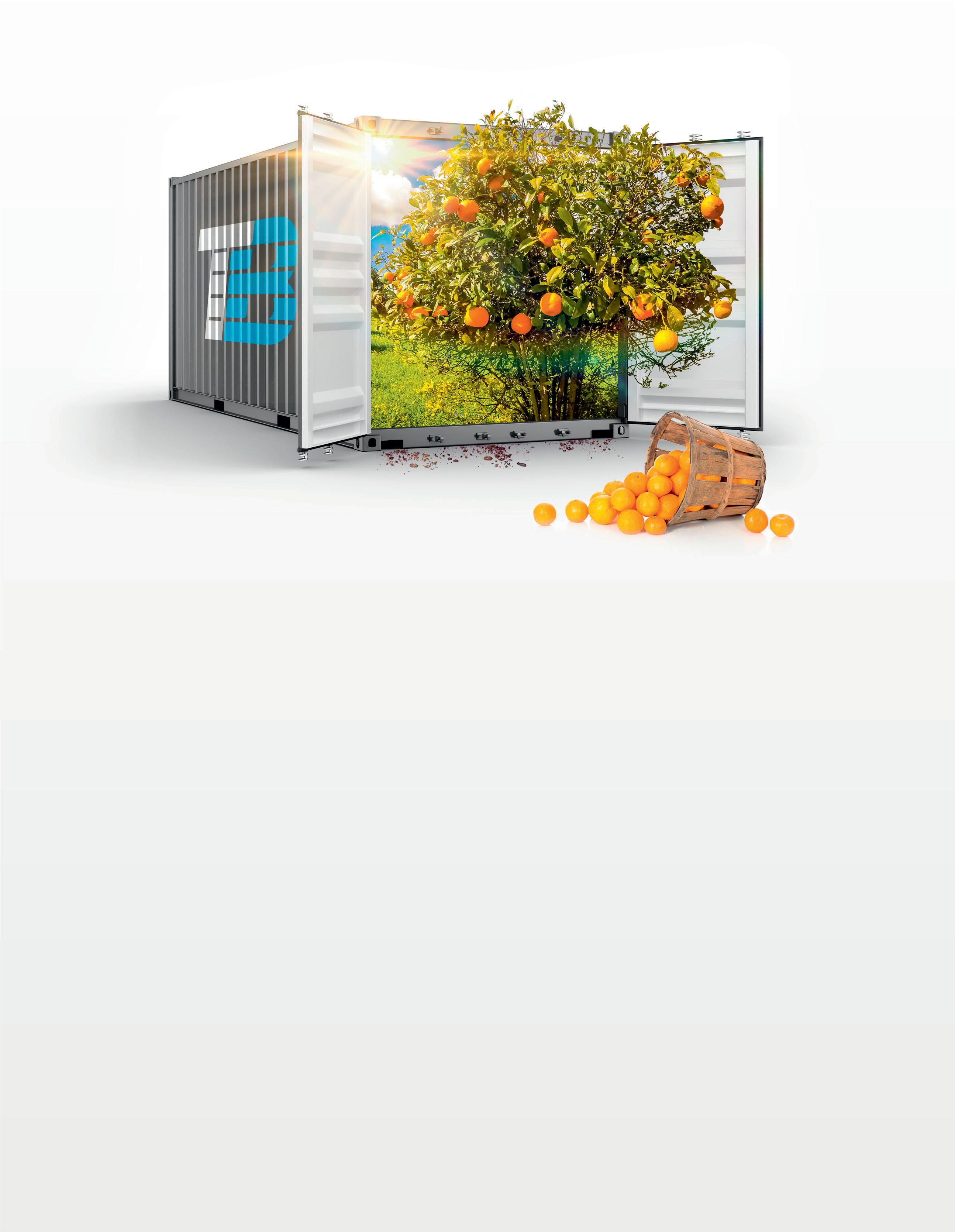
That is why we focus on delivering exceptional service to our customers ensuring each load is handled with care. Consider us your partner and lean on us for anything, anytime – because we believe it’s not just business, it’s personal.
Connect with us today and let’s take a look at how we can support your supply chain needs.